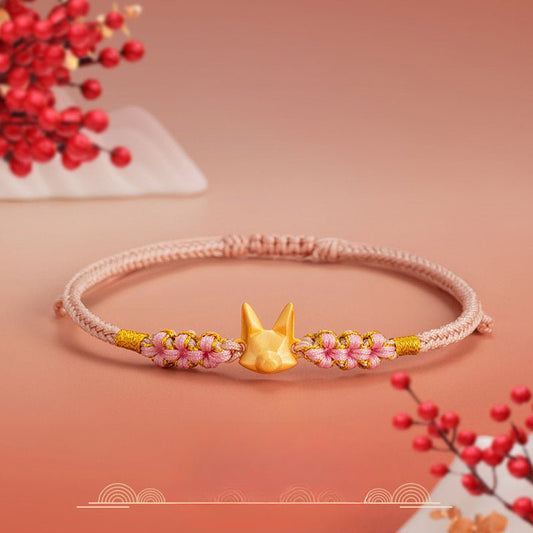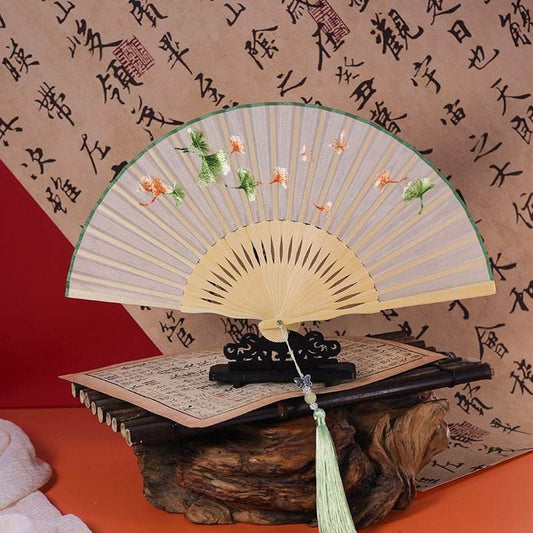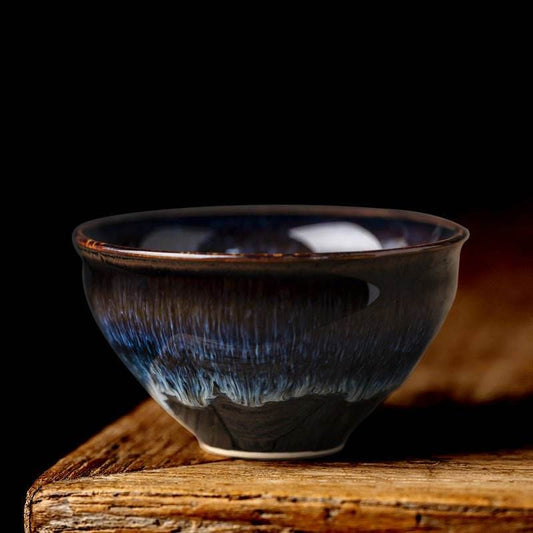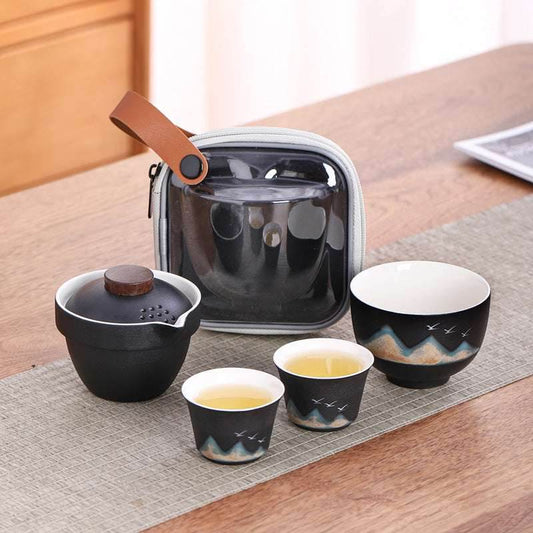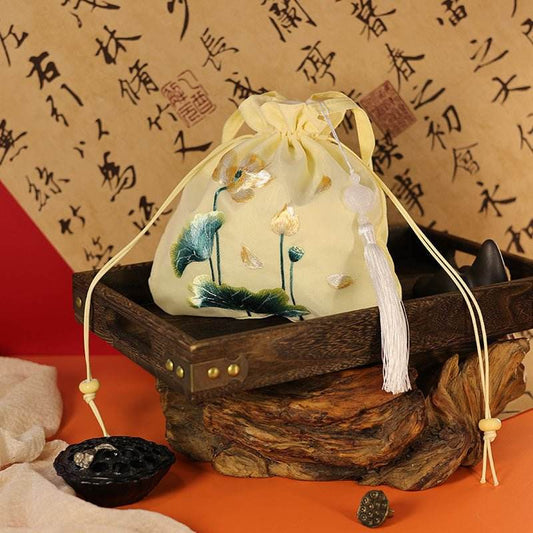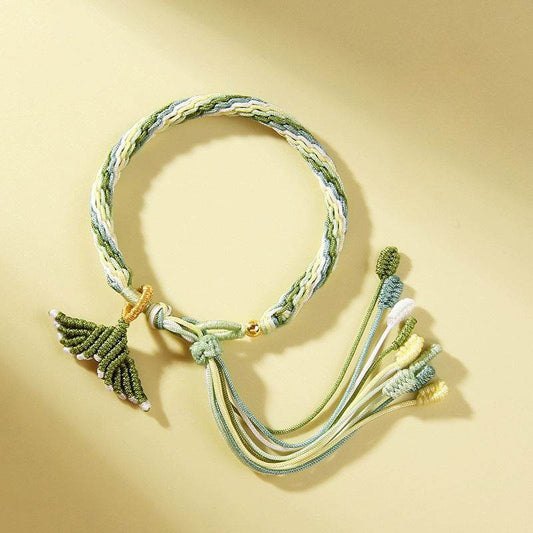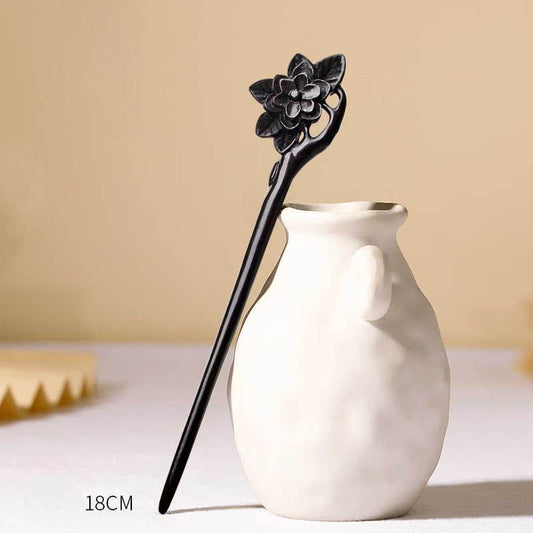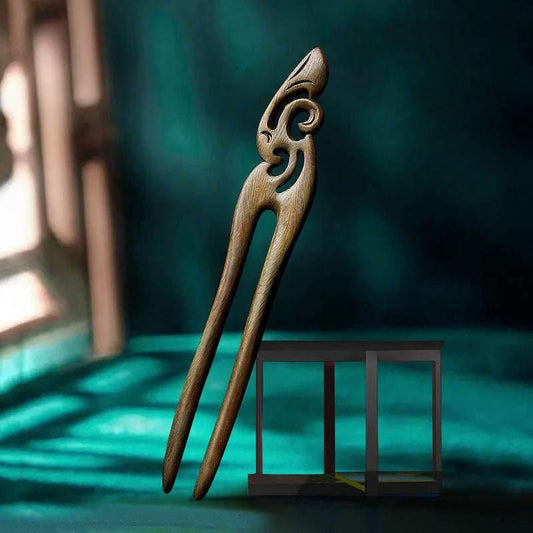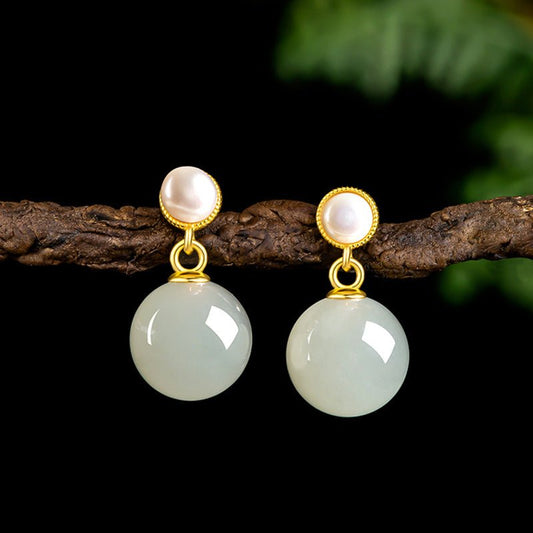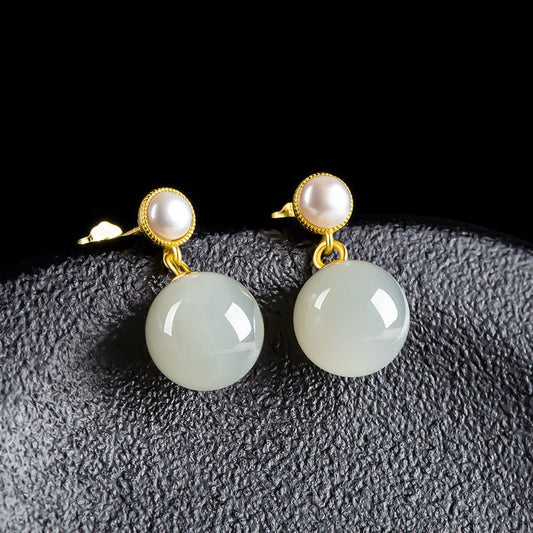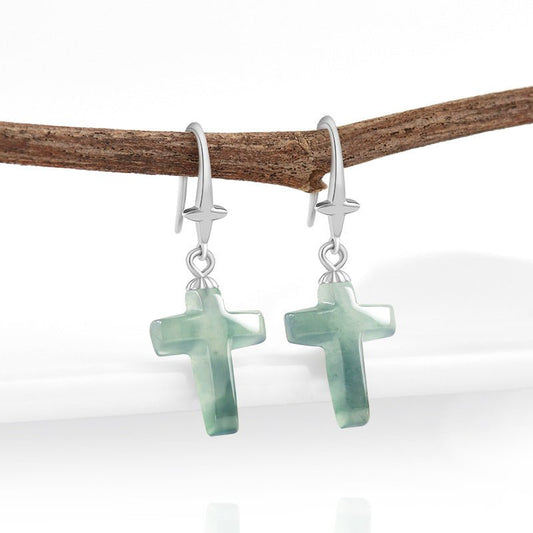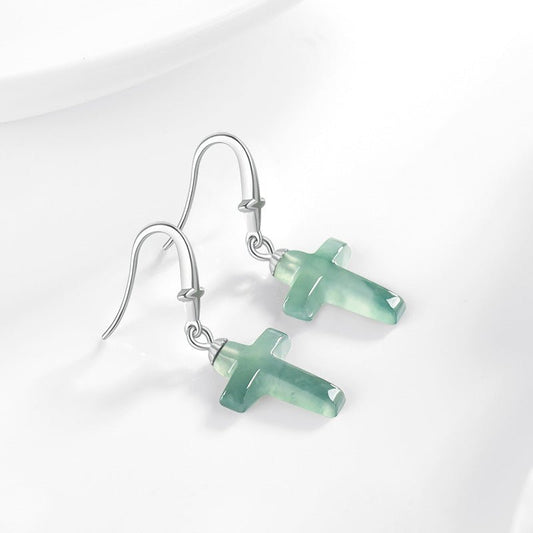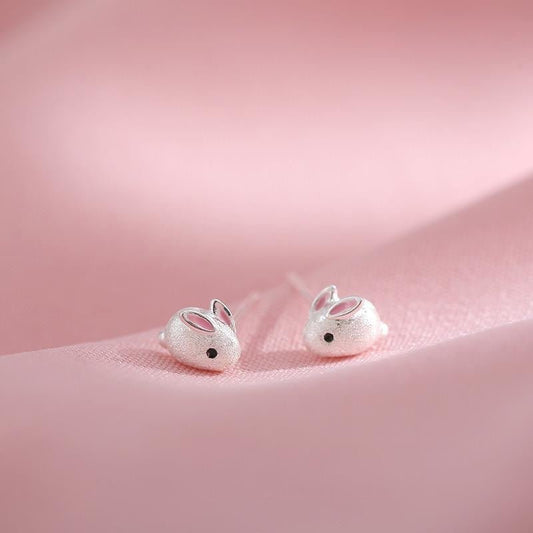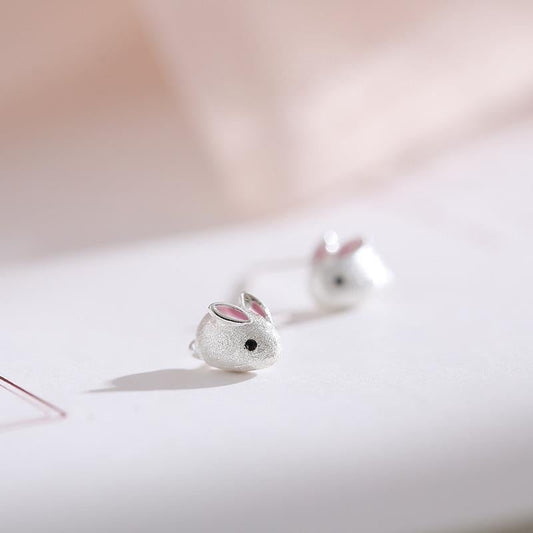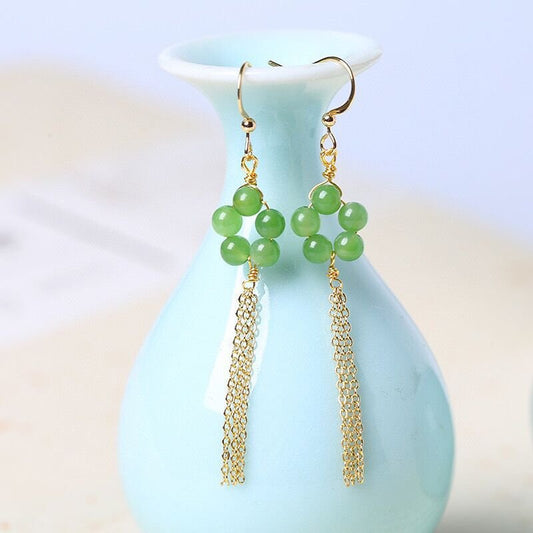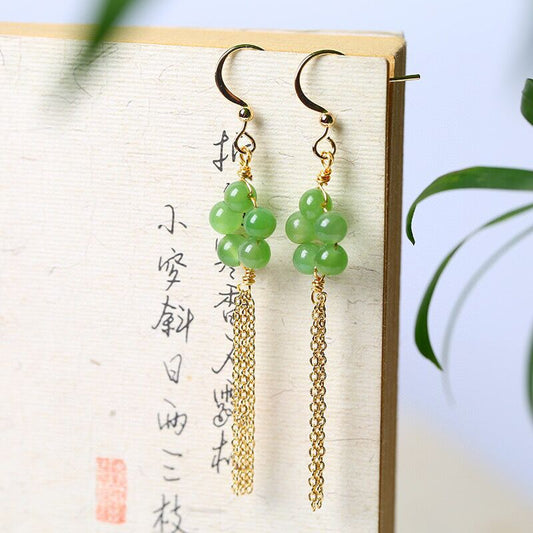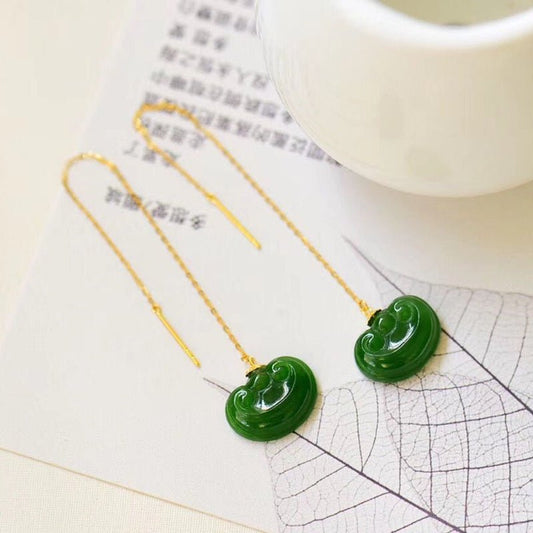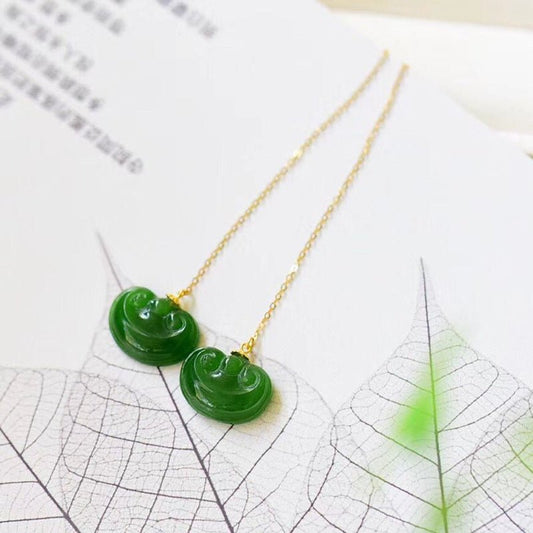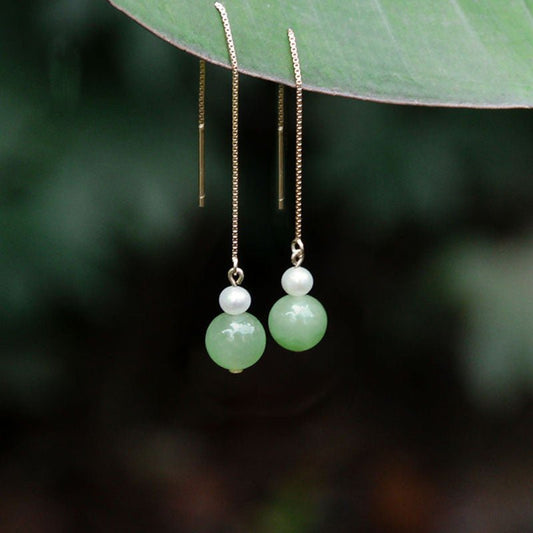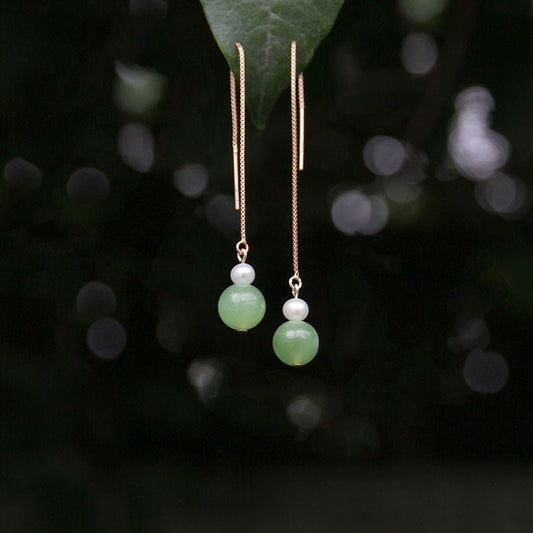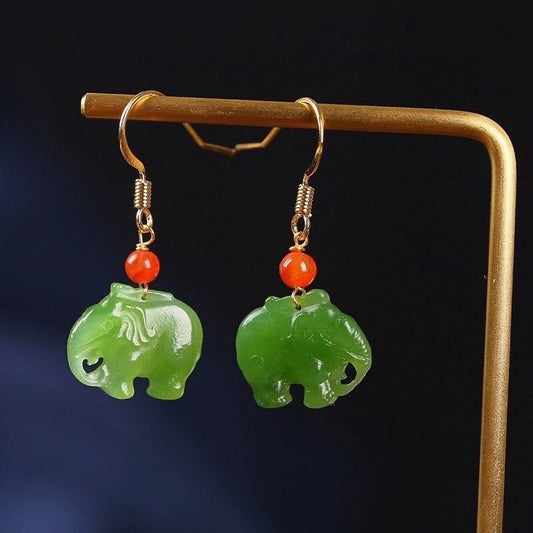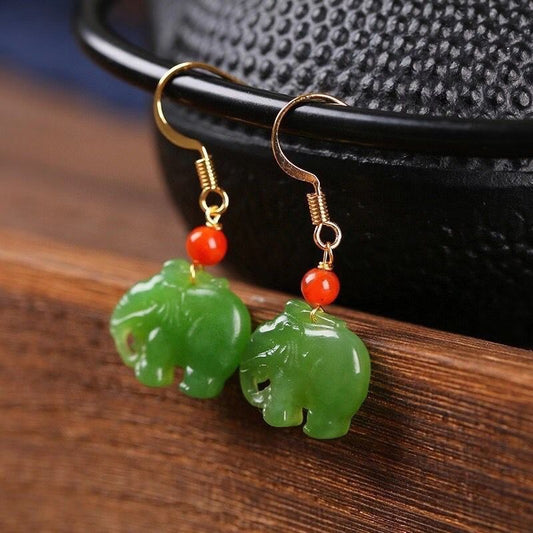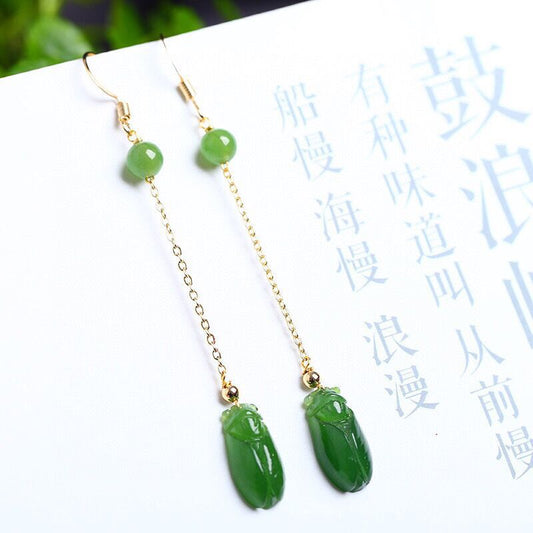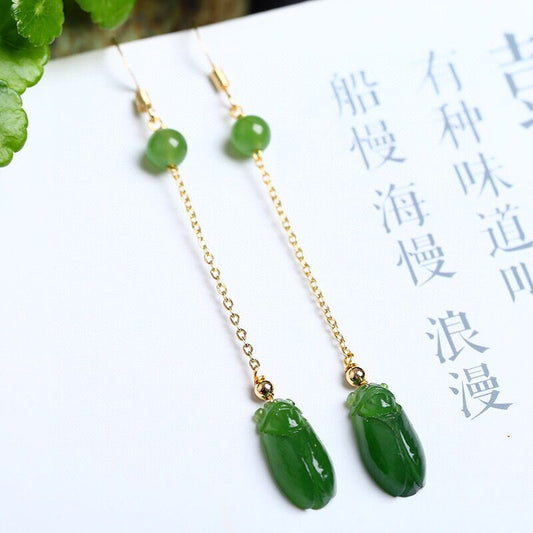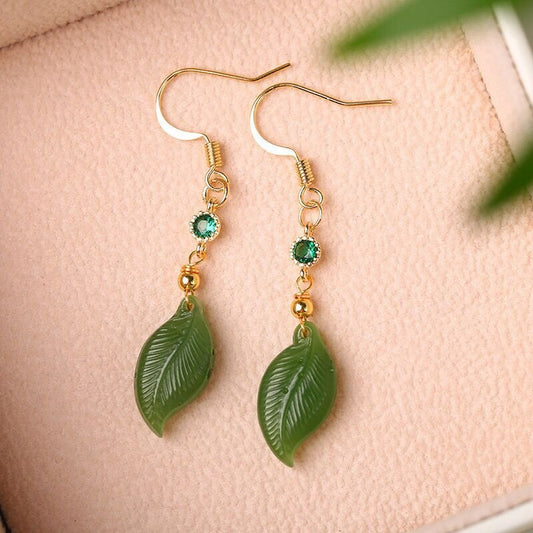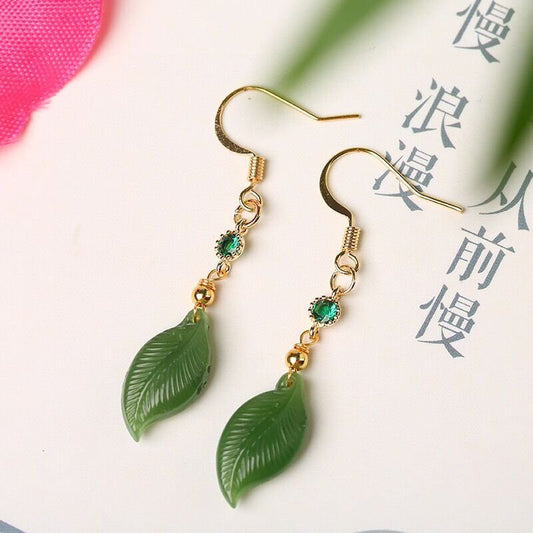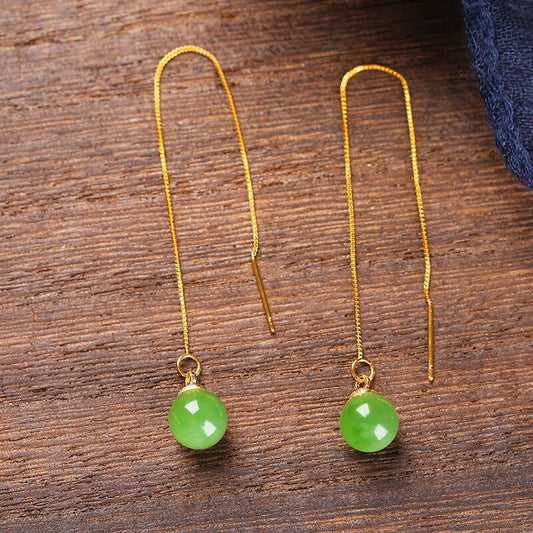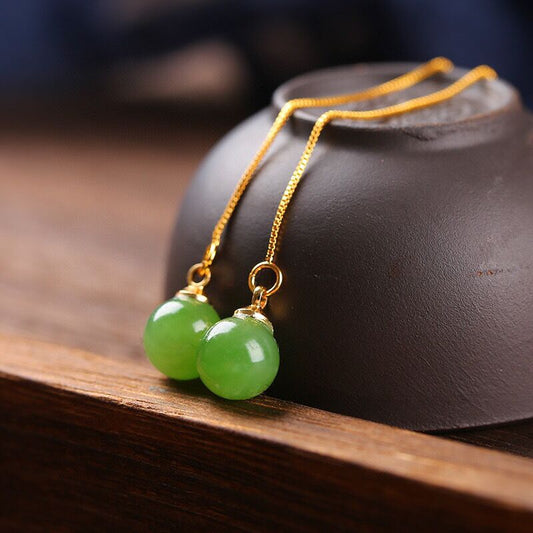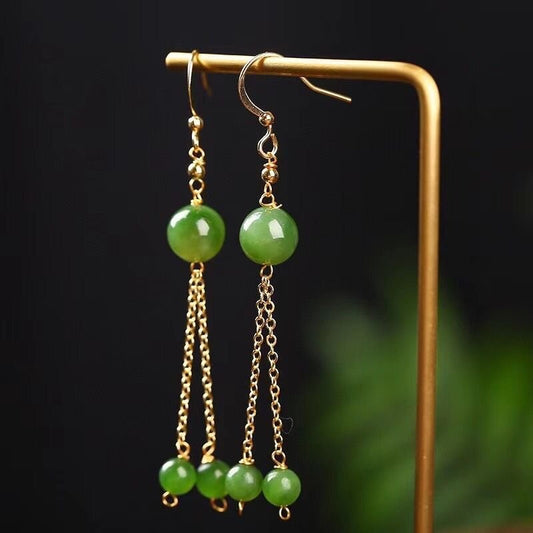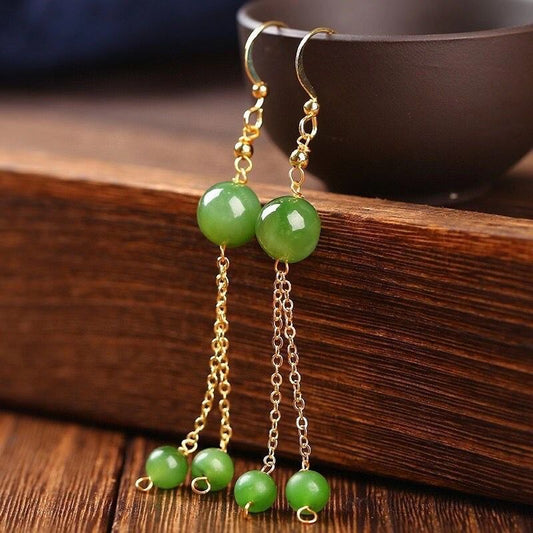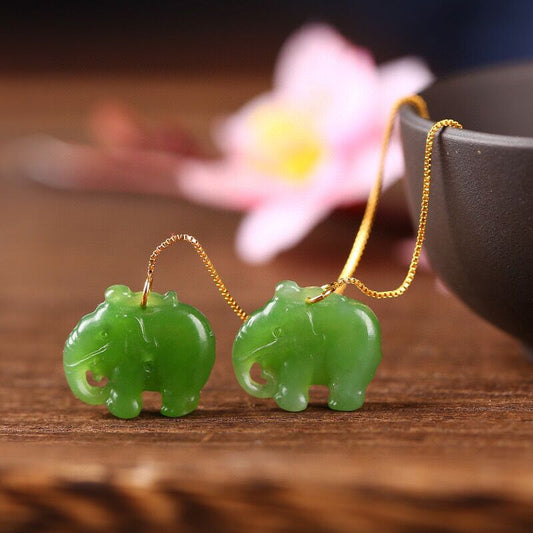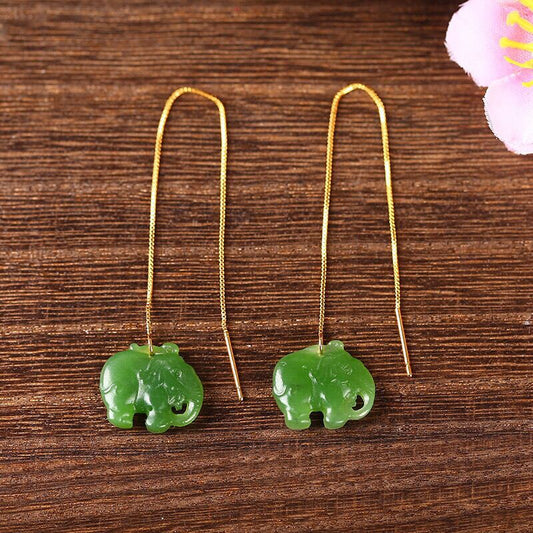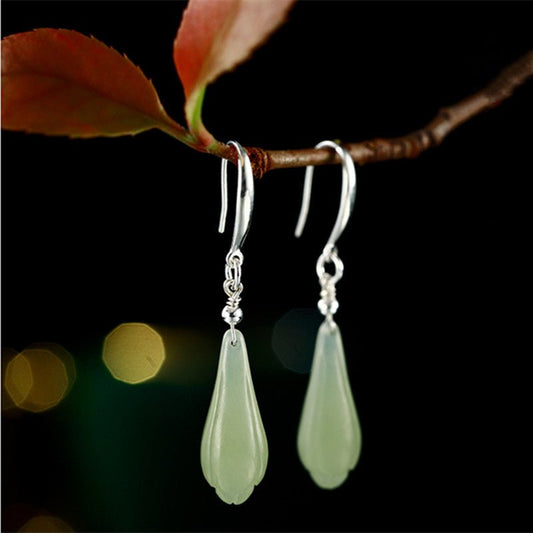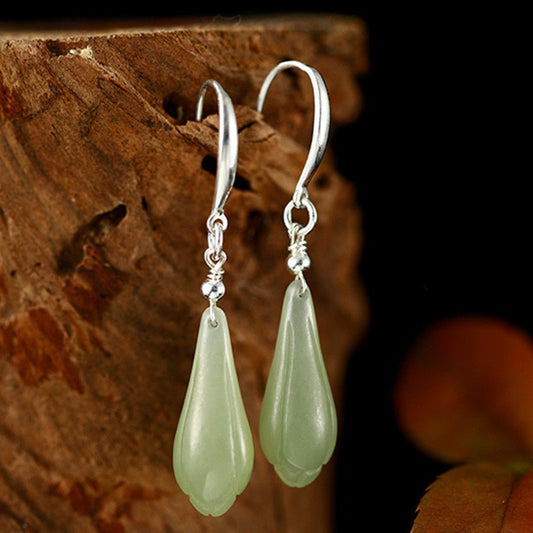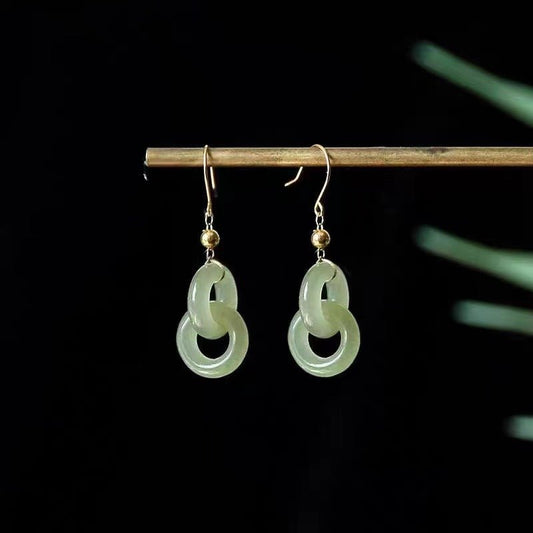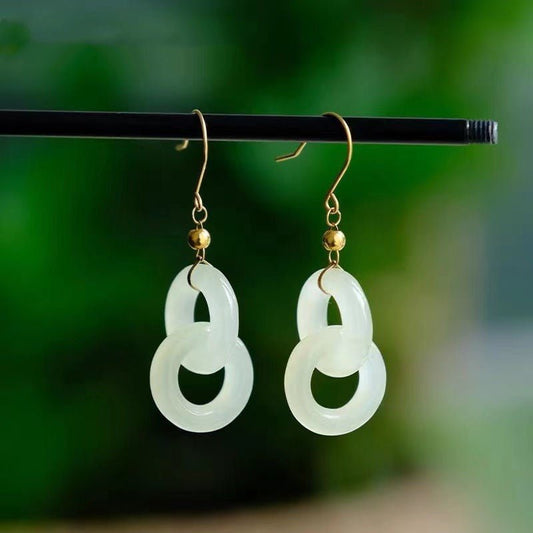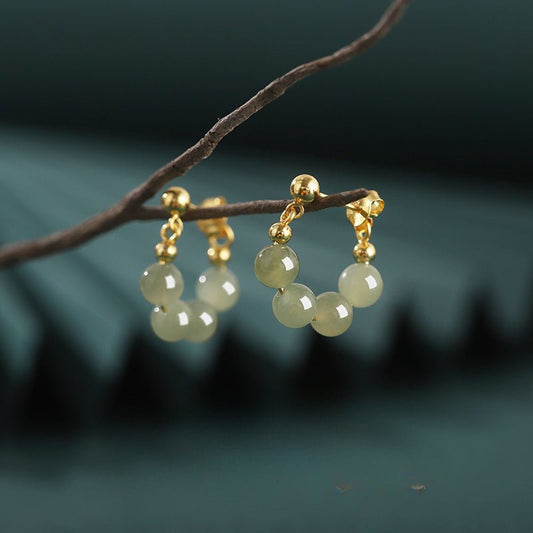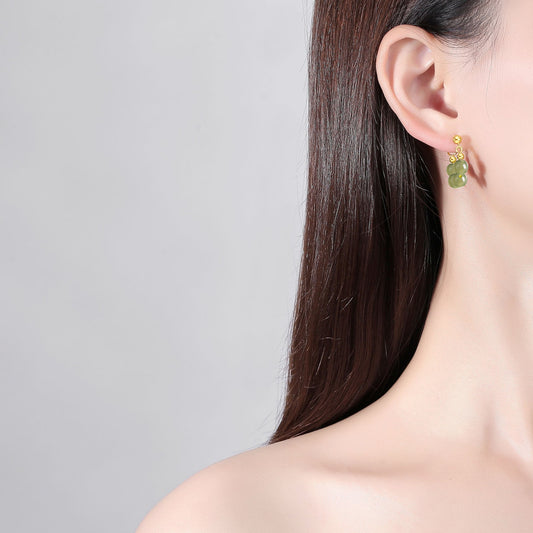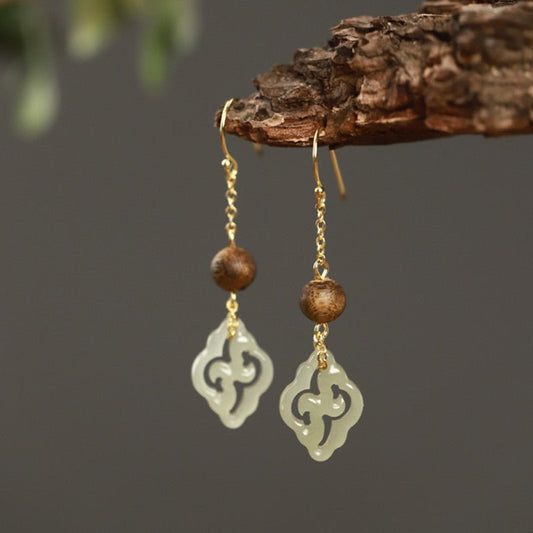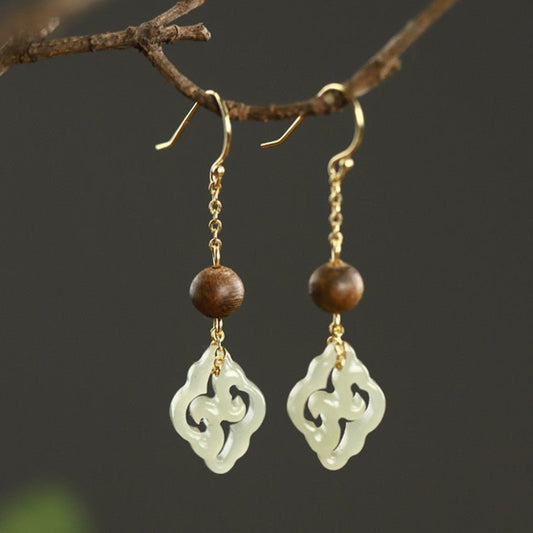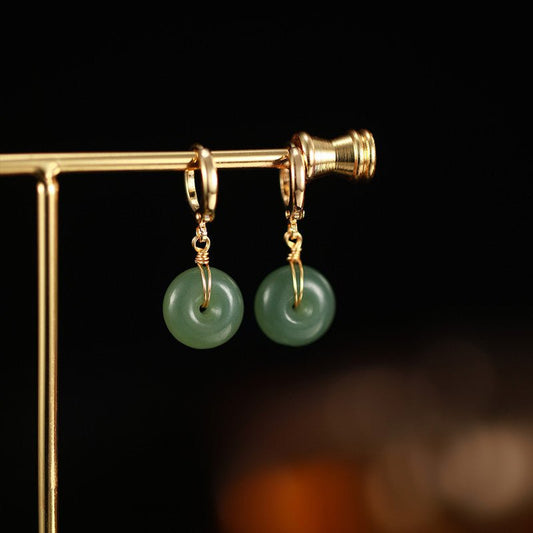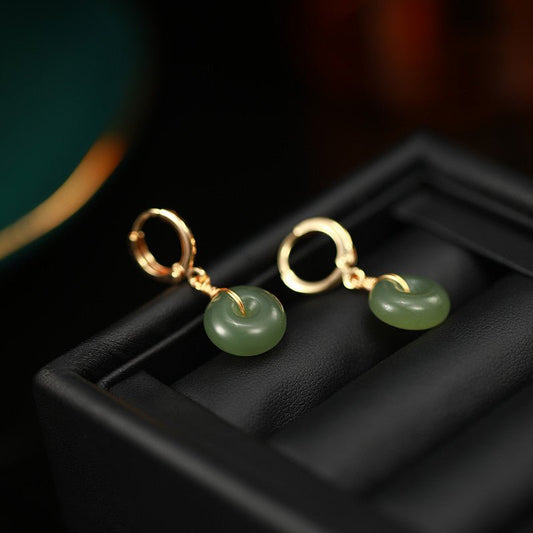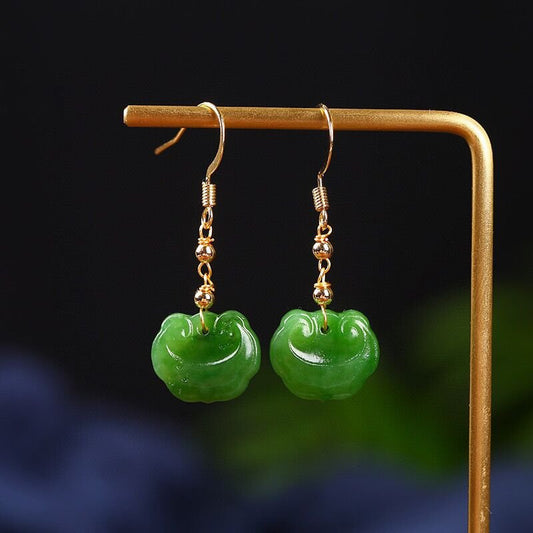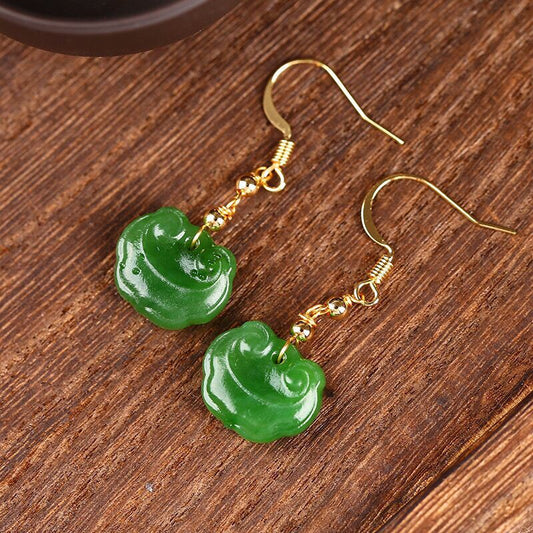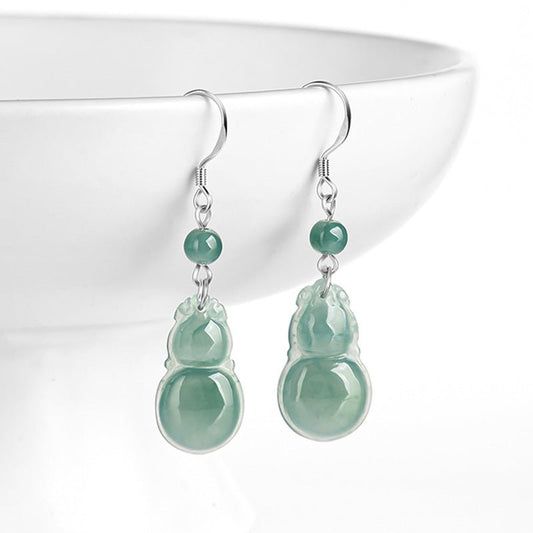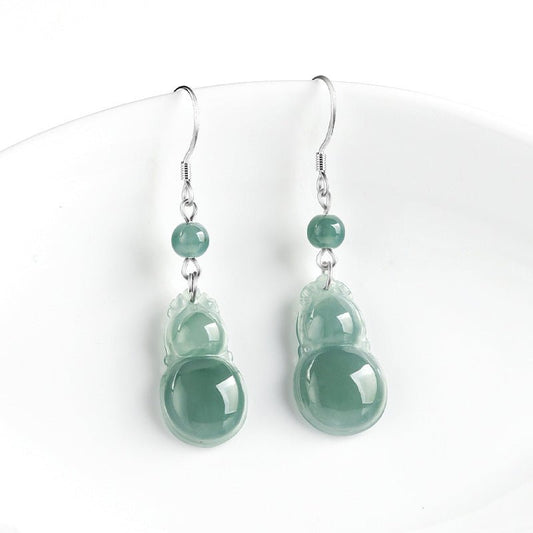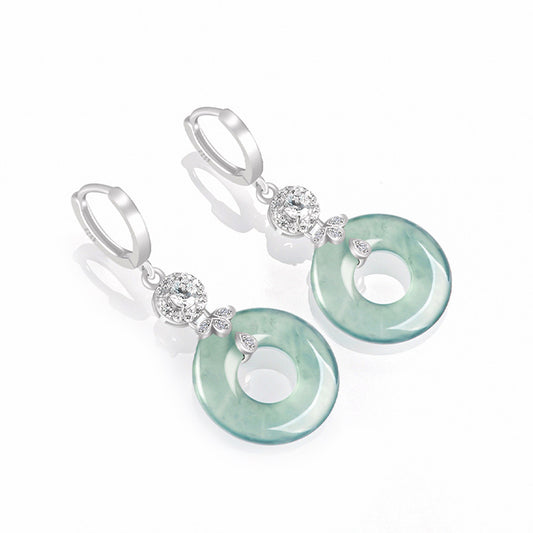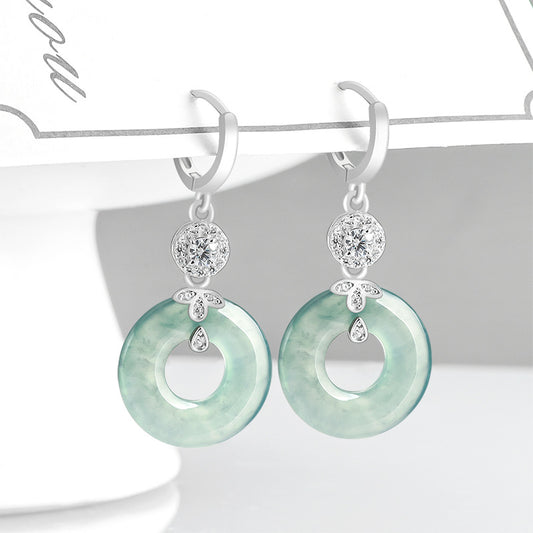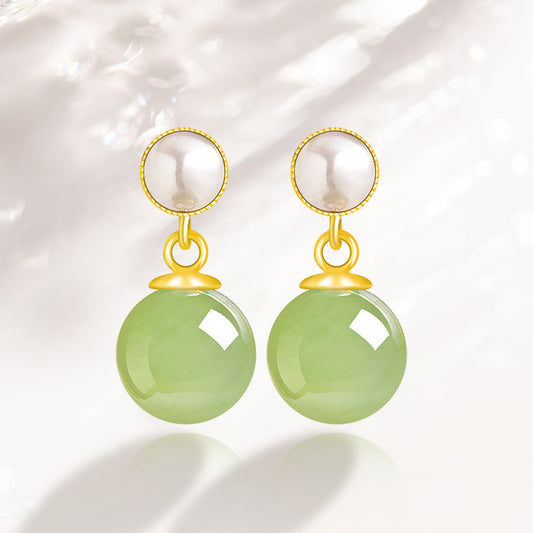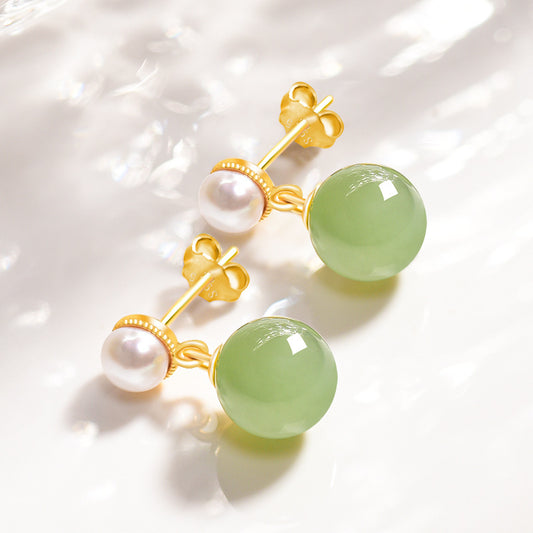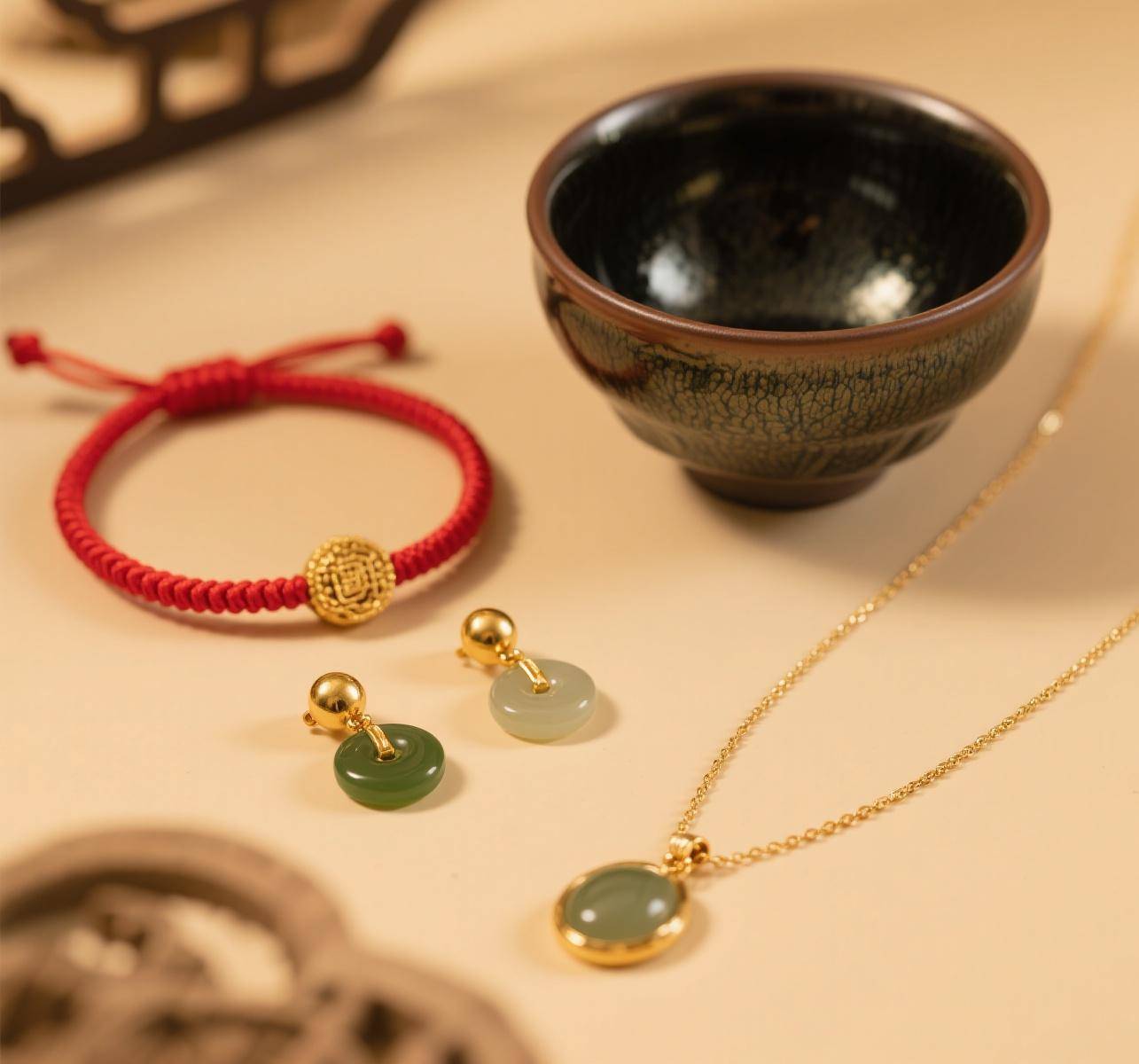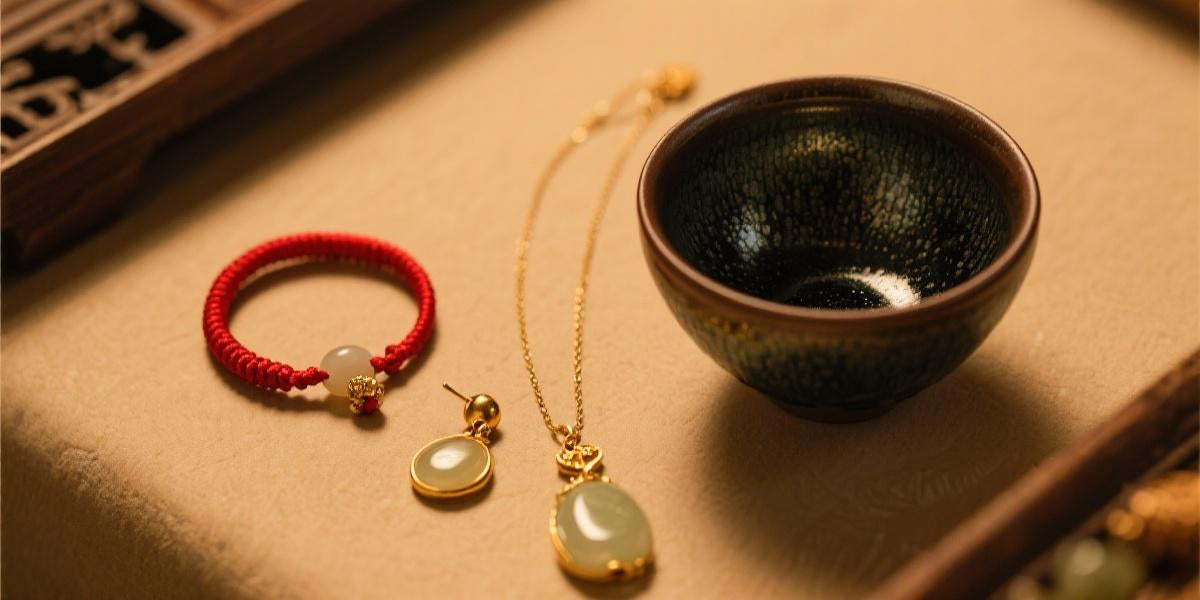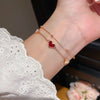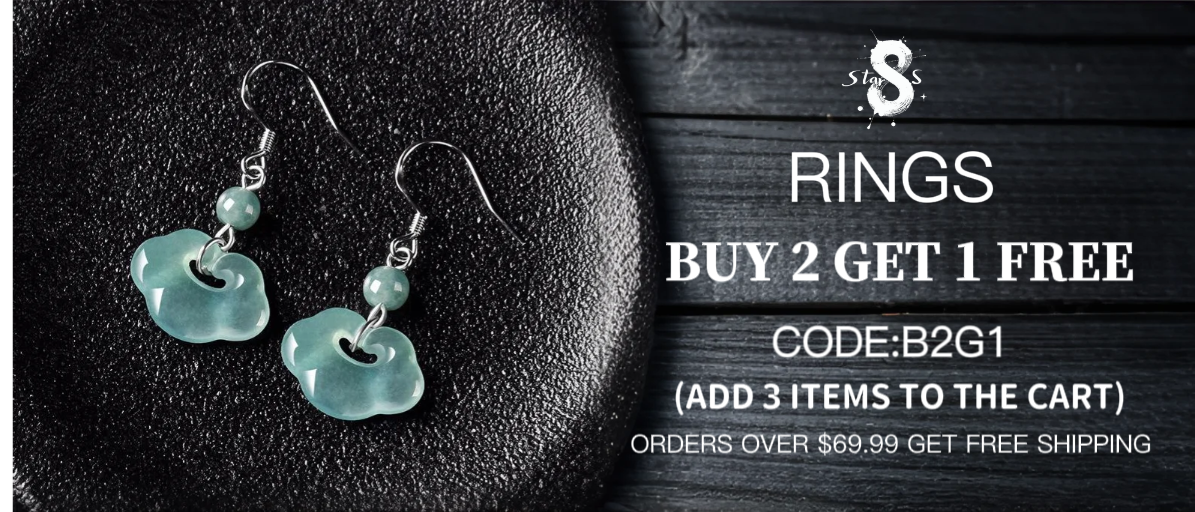
- Discover the elegance of earrings at STAR8S, where tradition meets beauty. Featuring symbols like dragons, lotus flowers, and phoenixes, these earrings are crafted from natural materials, offering spiritual balance and harmony. Each piece is designed to bring peace, good fortune, and timeless wisdom to your everyday style.
-
Pink Christmas Tree Earrings – Sparkling Holiday Jewelry for Women | Festive Rhinestone Dangle Earrings
Regular price $15.88save: 48% Sale price $15.88 Regular priceUnit price / per$31.13Add a touch of sparkle to your holiday look with these stunning Pink Christmas Tree Earrings! 🎀 Designed with shimmering rhinestones in soft pink tones, these earrings capture the joy and warmth of the festive season. Lightweight and elegant, they’re perfect for Christmas parties, seasonal events, or as a delightful gift for someone special. 🎅💖
Each earring features a beautifully detailed Christmas tree shape that glistens with every movement — a charming accessory that embodies the holiday spirit. Whether paired with a cozy winter sweater or a dazzling party dress, these earrings make your outfit shine bright this Christmas! 🌟
🌟 Key Features
-
🎄 Festive Design: Elegant Christmas tree shape in vibrant pink tones — adds instant holiday cheer!
-
💎 High-Quality Rhinestones: Sparkling crystal accents for a luxurious, eye-catching look.
-
🧷 Lightweight & Comfortable: Perfect for all-day wear — no ear strain or discomfort.
-
💖 Perfect Gift Idea: A thoughtful stocking stuffer or Secret Santa gift for friends and family.
-
🌸 Versatile Style: Complements both casual winter outfits and evening party attire.
🎁 Why You’ll Love It
✨ Celebrate Christmas in style — these earrings bring festive sparkle to any outfit.
💝 Great for gifting — elegant, trendy, and universally flattering.
🌟 Designed for comfort and glamour — shine all day and night!
🧾 Product Parameters
-
Material: Alloy base with high-shine rhinestones
-
Color: Pink with gold accents
-
Earring Type: Drop / Dangle
-
Closure Type: Push-back / stud post
-
Size: Approx. 4.5 cm × 2 cm (1.8 in × 0.8 in)
-
Weight: Lightweight (≈10 g/pair)
⚠️ Care & Attention
-
Avoid contact with water, perfume, and lotions.
-
Store in a dry jewelry box or pouch.
-
Clean gently with a soft, dry cloth after each use.
-
Handle with care to prevent rhinestone loss.
❓ FAQs
Q: Are these earrings hypoallergenic?
A: They are made with high-quality, nickel-free alloy, suitable for most skin types.Q: Can I wear them daily?
A: Yes! They are lightweight and comfortable enough for everyday wear during the festive season.Q: Do they come in a gift box?
A: Yes, each pair comes beautifully packaged — ready for gifting! 🎁Sale -
-
Red Christmas Tree Earrings with Bow Festive Holiday Jewelry - Perfect Gift for Women
Regular price From $13.49save: 52% Sale price From $13.49 Regular priceUnit price / per$28.49These enchanting Christmas tree earrings are the perfect way to spread holiday cheer! With their vibrant red enamel, sparkling diamond accents, and a charming bow on top, these earrings are designed to capture the magic of Christmas. The earrings feature a golden, festive design, giving them a luxurious and whimsical look. Whether you're heading to a Christmas party or looking for a thoughtful gift, these earrings will add a touch of elegance and festive fun to any outfit. 🎅✨
🎁 Perfect Gift: These earrings make an ideal present for any woman who loves the holiday season. Their unique design is sure to delight and bring smiles to faces. 💝
🌟 Key Features:
-
Design: Red enamel Christmas tree with a gold-tone finish, diamond accents, and a red bow.
-
Material: Durable alloy, enamel, and sparkling crystals.
-
Size: Earrings measure 3.62cm x 1.58cm (1.42in x 0.62in).
-
Weight: 5.8g (0.20oz), lightweight and comfortable for all-day wear.
-
Perfect for: Christmas parties, festive gatherings, holiday gifts, or any occasion to celebrate the holiday spirit! 🎉
⚠️ Care Instructions:
-
Keep earrings dry and away from harsh chemicals to maintain their sparkle.
-
Store in a cool, dry place when not in use to prevent tarnishing.
-
Clean gently with a soft cloth.
Sale -
-
Rhinestone Christmas Tree Earrings – Elegant Holiday Jewelry for Women
Regular price $15.98save: 48% Sale price $15.98 Regular priceUnit price / per$30.98🎄✨ Bring some sparkle to your holiday season with these Rhinestone Christmas Tree Earrings! Designed with a stunning Christmas tree motif, adorned with glittering rhinestones and a golden star, these earrings are perfect for adding elegance and festive charm to any outfit. Whether you're attending a Christmas party, enjoying a New Year’s celebration, or looking for the perfect holiday gift, these earrings will bring a touch of magic and joy to your look! 🎅💫
Key Features:
-
Elegant & Festive Design: A Christmas tree shape decorated with rhinestones and a golden star at the top, bringing both festive cheer and sparkle to your holiday look.
-
Lightweight & Comfortable: Made with lightweight materials, each earring weighs only 6.8g, making them easy and comfortable for all-day wear.
-
High-Quality Rhinestones: Sparkling rhinestones are set in a gold-tone metal frame, giving these earrings a luxurious, eye-catching shine.
-
Perfect for the Holidays: Ideal for Christmas parties, holiday gatherings, or adding festive flair to your winter wardrobe.
-
Ideal Gift: A delightful and charming holiday gift for friends, family, or anyone who loves elegant, festive jewelry. 🎁
Product Parameters:
-
Material: Rhinestones, Metal (Gold-tone finish)
-
Design: Christmas Tree with Rhinestone Detailing and Golden Star
-
Size: 5.3 cm (2.08 inches) x 2.1 cm (0.826 inches)
-
Weight: 6.8 g (0.24 oz) per earring
-
Color: Red and Green Christmas Tree with Gold-tone Metal and Rhinestones
-
Package Includes: 1 pair of earrings
-
Ideal for: Christmas celebrations, New Year's events, holiday parties, or as a festive gift.
Attention & Care:
-
Avoid Water: To maintain the sparkle and appearance, keep these earrings dry.
-
Storage: Store in a cool, dry place to protect the rhinestones and metal from damage.
-
Sensitive Skin: Please check for any allergic reactions before wearing these earrings for extended periods.
Sale -
-
Cartoon Santa and Christmas Tree Earrings with Pearls – Cute Holiday Earrings for Women
Regular price $13.88save: 48% Sale price $13.88 Regular priceUnit price / per$26.88🎄✨ Celebrate the holiday season with these adorable Santa Claus and Christmas Tree Earrings! Featuring a playful Santa design and a beautifully decorated Christmas tree, these earrings bring a fun and festive touch to any outfit. The addition of pearls enhances the design, making these earrings perfect for your Christmas parties, holiday gatherings, or as a charming gift for your loved ones. 🎅💖
Key Features:
-
Festive Design: A cute Santa figure paired with a Christmas tree adorned with pearls creates the perfect holiday accessory.
-
Lightweight & Comfortable: Each earring weighs only 6.9g, making them lightweight for all-day wear.
-
Premium Material: Made from high-quality acrylic and finished with shiny pearls, ensuring durability and a luxurious feel.
-
Perfect for the Holidays: These earrings are perfect for Christmas parties, New Year’s celebrations, or as a special holiday gift. 🎁
-
Charming Gift Idea: Ideal for friends, family, or anyone who loves festive jewelry. These earrings will add a touch of whimsy to any holiday ensemble.
Product Parameters:
-
Material: Acrylic, Pearl, Metal
-
Design: Santa Claus and Christmas Tree with Pearl Detail
-
Size: 3.11 cm (1.22 inches) x 1.26 cm (0.49 inches)
-
Weight: 6.9 g (0.24 oz) per earring
-
Color: Red, Green, White with Pearl Accents
-
Package Includes: 1 pair of earrings
-
Ideal for: Christmas parties, holiday events, or as a fun festive gift.
Attention & Care:
-
Avoid Water: Keep these earrings away from water to maintain their shine and appearance.
-
Storage: Store in a cool, dry place to avoid wear and tear.
-
Sensitive Skin: Test for any skin reactions before wearing for extended periods.
Sale -
-
Cartoon Acrylic Christmas Tree Earrings with Glittery Bows – Cute Holiday Jewelry for Women
Regular price $13.88save: 48% Sale price $13.88 Regular priceUnit price / per$26.88🎄✨ Add some fun and sparkle to your holiday season with these Cartoon Christmas Tree Earrings! Featuring vibrant Christmas trees adorned with Santa hats, colorful stars, and glittery bows, these earrings are the perfect accessory for your festive look. Made from premium acrylic, they are lightweight yet stylish, ideal for Christmas parties, holiday events, or as a fun gift. 🎅🌟
Key Features:
-
Playful & Festive Design: Each earring features a Christmas tree with a Santa hat, bright stars, and colorful decorations, finished with a glittery bow at the top. It's perfect for spreading holiday cheer!
-
Lightweight & Comfortable: Made from acrylic, these earrings are light and comfortable to wear, weighing just 7.3g each.
-
Vibrant Glitter Finish: The glittery bows and tree decorations add an extra touch of sparkle, making them eye-catching and fun for the season.
-
Perfect for Holiday Celebrations: Whether you're attending a Christmas party or exchanging gifts, these earrings are a fun way to add festive flair to your outfit.
-
Ideal Gift Idea: A fun and creative gift for friends and family who love to celebrate the holidays with a cheerful style. 🎁
Product Parameters:
-
Material: Acrylic, Glitter, Tassels
-
Design: Christmas Tree with Santa Hat and Glittery Bow
-
Size: 5.28 cm (2.07 inches) x 3.65 cm (1.43 inches)
-
Weight: 7.3 g (0.25 oz) per earring
-
Color: Green, Red, Yellow, and Glittery accents
-
Package Includes: 1 pair of earrings
-
Ideal for: Christmas parties, holiday events, casual festive outfits, and as a cute holiday gift.
Attention & Care:
-
Avoid Water: Keep the earrings away from water to preserve the glitter and material.
-
Storage: Store in a dry and cool place to maintain their long-lasting shine.
-
Sensitive Skin: Please check for any skin reactions before wearing for long periods.
Sale -
-
Christmas Tree Earrings with Glitter Star and Beads – Holiday Jewelry for Women
Regular price $8.88save: 52% Sale price $8.88 Regular priceUnit price / per$18.88✨🌲 Add a touch of festive glamour to your holiday look with these Christmas Tree Earrings! Featuring a dazzling design with sparkling stars and beaded chains, these earrings are a perfect blend of style and Christmas cheer. Made from high-quality acrylic and adorned with glittering sequins and shiny beads, these earrings will bring holiday sparkle wherever you go! Whether it's for a Christmas party or a special gift, these earrings are a must-have for the season. 🌟🎉
Key Features:
-
Unique Christmas Design: Featuring a colorful and sparkling Christmas tree with a golden star on top, making them a perfect match for your holiday outfits.
-
Festive Sparkle: Embellished with glitter sequins and beaded chains, giving these earrings a bright, festive look that catches the light beautifully.
-
Lightweight & Comfortable: At just 11.5g per earring, they’re light enough to wear all day without discomfort.
-
Durable & High-Quality Material: Crafted from premium acrylic to ensure long-lasting style and durability.
-
Perfect for Christmas: A wonderful accessory for Christmas gatherings, holiday parties, or as a seasonal gift. 🎁
-
Versatile Styling: These earrings complement any festive or casual holiday outfit, perfect for spreading Christmas cheer wherever you go.
Product Parameters:
-
Material: Acrylic, Glitter, Beads
-
Design: Christmas Tree with Star and Beaded Chains
-
Size: 6.9 cm (2.70 inches) x 4.7 cm (1.85 inches)
-
Weight: 11.5 g (0.40 oz) per earring
-
Color: Multicolored with Glittering Gold Star
-
Package Includes: 1 pair of earrings
-
Ideal for: Christmas celebrations, parties, holiday events, and festive gifts.
Attention & Care:
-
Avoid Water: Keep these earrings away from water and harsh chemicals to maintain their shine.
-
Storage: Store in a dry, cool place to avoid damage to the beads and sequins.
-
Sensitive Skin: Please check for any skin allergies before wearing for extended periods.
Sale -
-
Christmas Earrings with Reindeer & Snowflake Tree Design – Holiday Jewelry for Women
Regular price $8.88save: 52% Sale price $8.88 Regular priceUnit price / per$18.88🎄✨ Get into the festive spirit with our Christmas Acrylic Earrings, featuring a stunning Christmas Tree design adorned with a golden reindeer and sparkling snowflakes! Perfect for your holiday look, these earrings add a unique and playful touch to your outfit. Whether you're attending a Christmas party or simply want to spread holiday cheer, these earrings are the ideal accessory! 🎁❄️
Key Features:
-
Stylish & Festive Design: A fun and elegant combination of a Christmas tree with a golden reindeer, finished with a sprinkle of snowflakes for that magical holiday vibe.
-
Lightweight & Comfortable: Each earring weighs just 8g, making them easy and comfortable to wear all day long.
-
Perfect for Christmas & New Year: Ideal for both casual wear and holiday parties! Show off your festive spirit in style.
-
Durable Material: Made from premium acrylic, ensuring long-lasting beauty and resilience.
-
Perfect Gift Idea: A thoughtful and unique gift for friends, family, or anyone who loves the festive season. 🎅💝
Product Parameters:
-
Material: Acrylic
-
Design: Christmas Tree with Reindeer and Snowflakes
-
Size: 6 cm (2.36 inches) x 3.5 cm (1.37 inches)
-
Weight: 8.0 g (0.28 oz) per earring
-
Color: Green with Gold Reindeer
-
Package Includes: 1 pair of earrings
-
Ideal for: Holiday celebrations, Christmas parties, and festive outfits.
Attention & Care:
-
Avoid Water: To keep your earrings in great condition, avoid contact with water or harsh chemicals.
-
Storage: Store in a cool, dry place to maintain their shine and durability.
-
Allergy Notice: If you have sensitive skin, make sure to test for any skin irritation.
Sale -
-
Elegant Hetian Jade & Pearl Stud Earrings | S925 Silver Inlay | Stylish and Simple Design
Regular price $48.88save: 47% Sale price $48.88 Regular priceUnit price / per$92.90Elevate your style with these stunning Hetian jade and pearl stud earrings. Featuring smooth, lustrous Hetian jade set with delicate pearls, this jewelry piece captures the timeless beauty of natural jade and the sophistication of S925 silver. Whether you're dressing up for a special event or looking for a chic everyday accessory, these earrings are the perfect addition to your collection.
🌿 Product Highlights:
-
Premium Quality Hetian Jade: Known for its smooth texture and translucent color, this jade brings a serene and peaceful energy to the wearer.
-
Elegant Pearl Accents: A beautiful pearl is set above each jade ball, adding a touch of sophistication and shine.
-
Durable S925 Silver: The earrings are securely held in place with high-quality S925 silver, ensuring durability and long-lasting beauty.
-
Perfect for Any Occasion: Simple yet elegant, these earrings are perfect for both casual and formal events.
-
Gift-Worthy: An ideal gift for loved ones, special occasions, or just as a treat to yourself. 🎁
💎 Dimensions:
-
Height: 18.5mm
-
Width: 9.8mm
-
Thickness: 9.8mm
-
Weight: 3.8g
🌱 Care Tips:
To maintain the brilliance of these earrings, avoid contact with chemicals, and store them in a dry, cool place. Regularly clean with a soft cloth to keep their natural shine.Notes:
-
Customization: Available in different pearl colors or jade shades.
-
Maintenance: Gently clean using a soft, non-abrasive cloth to preserve the jade's shine.
Perfectly balancing classic elegance with modern minimalism, these Hetian jade and pearl stud earrings are a must-have for any jewelry lover. Add them to your cart today and shine with natural luxury! 🌟
Sale -
-
Jade Blue Water Cross Earrings S925 Silver Inlaid Ice Jade Earrings Safety Earrings
Regular price $43.88save: 51% Sale price $43.88 Regular priceUnit price / per$90.99Elevate your jewelry collection with these Jade Cross Earrings, beautifully crafted with Ice-Seed Jade and set in high-quality S925 silver. These earrings combine classic elegance with contemporary design, featuring a stunning cross-shaped jade pendant that reflects light and shines with its natural, smooth texture. Whether you're looking for a unique accessory or a meaningful gift, these earrings are the perfect choice. ✨
Key Features:
-
Material: Premium Ice-Seed Jade, known for its clarity, smoothness, and beautiful green hue.
-
Design: The cross pendant gives a modern twist to traditional jade jewelry, combining both elegance and strength.
-
Eco-Friendly: Made with natural materials and environmentally conscious practices, ensuring you make a stylish and sustainable choice.
-
S925 Silver: The silver setting is crafted with S925 silver, a durable and hypoallergenic material that ensures comfort and longevity.
-
Perfect for All Occasions: These earrings are ideal for everyday wear or special events, making them versatile for any style.
💎 Why Choose These Jade Cross Earrings?
Jade has always been admired for its "five virtues"—tough texture, moisture, luster, and beautiful color. This makes these earrings a meaningful addition to your jewelry collection, representing not just beauty, but also protection and strength. The unique cross shape adds a spiritual touch, making them the perfect accessory for those who value both fashion and symbolism. 💚Product Specifications:
-
Material: Ice-Seed Jade, S925 Silver for the setting
-
Pendant Dimensions: Height: 15.5 mm, Width: 12.5 mm, Thickness: 3.0 mm
-
Weight: 2.0g (per earring)
-
Color: Green
Care Instructions:
-
Avoid exposure to chemicals such as perfumes, lotions, or hair sprays to maintain the shine of the jade.
-
Clean gently with a soft cloth to preserve the luster of the jade and silver setting.
-
Store in a cool, dry place away from direct sunlight and humidity to keep the jade in pristine condition.
🎁 Perfect Gift:
These Jade Cross Earrings make a thoughtful and meaningful gift for a loved one. Ideal for birthdays, anniversaries, or any special occasion, these earrings combine luxury, style, and sentiment in one beautiful package. ✨Sale -
-
S925 Silver Rabbit Earrings – Cute Minimalist Forest Style Earrings for Girls & Students
Regular price $8.88save: 58% Sale price $8.88 Regular priceUnit price / per$21.27✨ These adorable S925 silver rabbit earrings bring a touch of nature to your accessories collection. Designed with a minimalistic yet playful approach, these earrings are perfect for those who love cute and dainty jewelry. Their bunny design is charming, making them an ideal addition for students, young girls, or anyone with a fondness for forest-style jewelry 🌿🐇. Whether you're dressing up for a casual day or adding some whimsy to a more formal outfit, these earrings will make the perfect statement. 💕
🌸 Key Features:
-
Material: Premium S925 Silver – Hypoallergenic and Safe for Sensitive Ears 🛡️
-
Design: Cute rabbit shape with delicate details that add charm and innocence ✨
-
Size: Small and lightweight, making them perfect for everyday wear 💫
-
Finish: High-quality silver with a soft matte finish that is durable and eye-catching 🌟
-
Occasions: Great for school, casual outings, or as a sweet gift for a loved one 💝
-
Gender: Ideal for girls and young women who love minimalist accessories with a playful twist 🐰
🔒 Product Details:
-
Dimensions: 10mm x 7mm (L x H)
-
Weight: Light and comfortable, each earring weighs approximately 1.5g
-
Closure: Stud style with a secure backing that ensures comfort throughout the day 🎉
🔍 Why You’ll Love It:
-
Minimalist Design: These earrings blend simplicity with elegance, perfect for those who appreciate understated beauty 💕.
-
Unique Look: The cute rabbit shape adds a touch of innocence and fun to any outfit 🐇💖.
-
High-Quality Material: Made from hypoallergenic S925 silver, they are gentle on the skin and will last for a long time, ensuring both style and comfort 🌟.
-
Versatile Style: Whether you're in school, at work, or just hanging out with friends, these earrings will complement any look. 👗
💡 Care Instructions:
-
Keep earrings dry and avoid exposure to harsh chemicals to maintain their silver shine ✨.
-
Store in a cool, dry place when not in use to prevent tarnishing 🔒.
-
Clean with a soft cloth to preserve the finish and luster 🌈.
Add a Little Playfulness to Your Look: These adorable rabbit-shaped earrings are sure to steal hearts. Perfect for anyone who loves cute, delicate accessories, they’ll add a touch of fun to any outfit! 🐰💫
Sale -
-
Natural Hetian Jade 5mm Round Bead Drop Earrings for Women – Simple & Elegant Gold Chain Tassel Earrings
Regular price $33.88save: 51% Sale price $33.88 Regular priceUnit price / per$69.53Add a touch of nature-inspired elegance to your jewelry collection with these Natural Hetian Jade 5mm Round Bead Drop Earrings. Perfect for both casual and formal occasions, these earrings are designed to elevate your style with their timeless beauty and versatility.
💎 Key Features:
-
Material: Authentic Hetian jade, known for its smooth texture and rich green hue.
-
Design: Unique and delicate 5mm round jade beads elegantly suspended from golden ear hooks. A subtle yet striking drop design with golden chain tassels.
-
Size: Each jade bead measures 5mm, offering the ideal balance of size and elegance.
-
Style: Minimalistic and chic, these earrings pair effortlessly with any outfit – from daily wear to special events. 🌟
-
Hypoallergenic: Crafted with hypoallergenic materials to ensure comfort for sensitive ears.
-
Weight: Lightweight, making them easy to wear throughout the day. 🌸
🎁 Why You’ll Love These Earrings:
-
Timeless Elegance: Hetian jade is valued for its purity and spiritual significance, symbolizing peace, harmony, and beauty. 🌿
-
Versatile Fashion Piece: Whether dressing up for a dinner or a casual outing, these earrings will complement any look, making them perfect for all occasions.
-
Thoughtful Gift: Ideal for birthdays, anniversaries, or just to show someone how much you care. 💖
📏 Product Specifications:
-
Bead Size: 5mm round jade beads
-
Material: 100% natural Hetian jade, gold-plated chain tassels
-
Ear Wire Type: Hypoallergenic gold-plated hooks
-
Color: Rich jade green with natural variations, ensuring each pair is unique 🌱
-
Total Length: 6 cm from top to bottom (including the gold chain tassels)
-
Weight: 3 grams per earring
⚠️ Important Care Instructions:
-
As these earrings are made from natural jade, expect slight color variations, which add to their uniqueness. 🌿
-
To maintain their beauty, avoid exposing the earrings to chemicals, perfumes, or moisture.
-
Gently clean with a soft cloth to maintain the natural luster of the jade.
-
Store in a cool, dry place when not in use to prevent tarnishing.
🌟 Elevate your style with these Natural Hetian Jade Earrings. Whether you're treating yourself or giving a gift, these earrings are the perfect choice for adding a timeless touch to any wardrobe. 🌟
Sale -
-
Natural Hetian Jade Earrings & Necklace Set – Cloud Design, 12mm, Simple & Versatile Jewelry Gift for Women
Regular price From $33.88save: 51% Sale price From $33.88 Regular priceUnit price / per$69.53💎 Key Features:
-
Material: Authentic Hetian Jade, prized for its smooth texture, rich green hue, and natural beauty.
-
Design: Classic cloud design with a 12mm jade stone, offering a harmonious balance of simplicity and intricate craftsmanship.
-
Size: Approx. 12mm jade charm – the ideal size for both earrings and the necklace pendant, striking the perfect balance between subtlety and statement.
-
Style: Minimalist and versatile, these pieces can be worn daily or for special occasions, adding a subtle touch of nature-inspired elegance. 🌸
-
Hypoallergenic: Suitable for sensitive skin, ensuring comfort for all-day wear.
-
Weight: Light and easy to wear, perfect for any occasion. 💚
🎁 Why Choose This Set?
-
Timeless Elegance: Hetian Jade symbolizes purity, harmony, and wisdom. This set provides a lasting, natural appeal, making it a perfect complement to any style.
-
Versatile & Practical: Whether for work, casual outings, or special celebrations, this set’s minimalist design suits any event or personal style.
-
Ideal Gift: A thoughtful gift idea for loved ones. The jade earrings and necklace set is perfect for birthdays, anniversaries, or simply to show someone how much you care. 🎉
📏 Product Specifications:
-
Bead Size: Approx. 12mm jade beads (both for earrings and necklace)
-
Material: 100% Natural Hetian Jade, gold-plated metal (earrings hooks and necklace chain)
-
Design: Cloud-shaped jade pendant
-
Color: Natural jade green (may vary slightly due to natural jade qualities) 🍃
-
Necklace Length: 40 cm (adjustable)
-
Earring Length: 4 cm (drop length)
-
Weight: 3 grams per earring
⚠️ Important Care Instructions:
-
As each jade piece is naturally unique, there may be slight variations in color and texture, ensuring that each set is one-of-a-kind. 🌿
-
Avoid exposing the jade to harsh chemicals, perfumes, or excessive moisture to preserve its beauty.
-
Clean the jade gently with a soft cloth to maintain its luster and shine.
-
Store your jewelry in a dry, cool place when not in use to avoid tarnishing the gold-plated finish.
🌟 Add a touch of nature’s elegance to your wardrobe with this exquisite Hetian Jade Earrings & Necklace Set. A timeless and versatile accessory that complements any outfit and serves as the perfect meaningful gift. 🌟
Sale -
-
14k Gold-Plated Pearl & Jade 6mm Round Bead Drop Earrings – Elegant & Minimalist Gift for Women
Regular price $18.88save: 57% Sale price $18.88 Regular priceUnit price / per$44.11Elevate your jewelry collection with these 14k Gold-Plated Pearl & Jade 6mm Round Bead Earrings. A perfect blend of sophistication and simplicity, these earrings are designed to complement any outfit, adding a chic and timeless touch to your look. Ideal for any occasion, they make a thoughtful gift or a stunning personal accessory. 🌿
💎 Key Features:
-
Material: High-quality 14k gold-plated metal, enhanced with freshwater pearls and natural jade stones.
-
Design: Delicate 6mm jade beads paired with luminous white pearls, suspended from a sleek gold chain for an elegant drop earring design.
-
Size: 6mm jade bead diameter; designed for a refined, balanced look.
-
Style: Modern, minimalist elegance – perfect for daily wear or as an accessory to formal outfits. ✨
-
Hypoallergenic: Safe for sensitive ears, providing all-day comfort without irritation.
-
Weight: Lightweight for easy wear, ideal for all-day comfort. 🌸
🎁 Why Choose These Earrings?
-
Versatile Elegance: These earrings are crafted to complement both casual and formal wear, adding a subtle elegance to your look.
-
Timeless Appeal: Combining the natural beauty of jade with the classic charm of pearls, these earrings embody lasting style.
-
Perfect Gift Idea: These earrings make a thoughtful gift for birthdays, anniversaries, or special occasions, offering timeless beauty to those you care about. 🎉
📏 Product Specifications:
-
Bead Size: 6mm round jade bead and freshwater pearl accents
-
Material: 14k gold-plated metal, natural jade, freshwater pearls
-
Ear Wire Type: Gold-plated hook
-
Color: Natural green jade, white pearls with gold accents
-
Length: 5 cm (from top to bottom, including the gold chain drop)
-
Weight: 4 grams per earring
⚠️ Important Care Instructions:
-
Due to the natural origin of the jade and pearls, there may be slight variations in color and texture, making each pair unique. 🌿
-
To maintain the gold-plated finish, avoid exposing the earrings to harsh chemicals, perfumes, or excessive moisture.
-
Clean gently with a soft cloth to retain the luster of the gold and jade.
-
Store in a dry, cool place to prevent tarnishing and preserve their beauty.
🌟 Enhance your jewelry collection with these beautiful 14k Gold-Plated Pearl & Jade Earrings. Whether you're treating yourself or giving a meaningful gift, these earrings are sure to impress. 🌟
Sale -
-
Natural Jade Elephant Earrings (13mm) | Simple & Fresh Design
Regular price $33.88save: 50% Sale price $33.88 Regular priceUnit price / per$69.11Add a touch of nature’s beauty to your jewelry collection with these Natural Jade Elephant Earrings. Carved with delicate detail, these 13mm jade elephants are a symbol of wisdom, strength, and good fortune. Set with vibrant red beads, the earrings offer a simple yet charming aesthetic perfect for daily wear or special occasions. The green jade material is not only visually stunning but also believed to bring peace and calm to its wearer. Ideal for those who appreciate understated elegance with a natural twist.
Product Features:
-
Material: Premium Jade
-
Size: Approx. 13mm per elephant
-
Design: Simple & Fresh with Elephant Motif 🐘
-
Color: Green Jade with Red Beads ❤️
-
Style: Minimalistic, Nature-Inspired Design 🌱
-
Perfect for: Daily wear, gifts, nature lovers 🌿🎁
-
Hypoallergenic: Safe for sensitive skin 🌿✨
-
Occasion: Casual, parties, nature-themed events, or gifting 💝
Care Instructions:
-
Store in a dry, cool place to maintain the jade’s natural shine and color.
-
Avoid contact with chemicals or abrasive materials.
-
Clean with a soft cloth to keep the jewelry looking fresh.
Why Choose Our Jade Elephant Earrings?
-
Symbolic Meaning: The elephant is a revered symbol of wisdom, power, and good luck. Wearing these earrings can help attract positive energy into your life.
-
Elegant Design: The jade’s deep green hue is calming and suits all types of skin tones, while the simple yet stylish design adds a refreshing touch to any outfit.
-
Thoughtful Gift: Ideal for friends, family, or loved ones, especially those who cherish nature or enjoy cultural symbols.
Sale -
-
Natural Hetian Jade Golden Cicada Earrings | Original Design, Fashionable for Women
Regular price $38.88save: 48% Sale price $38.88 Regular priceUnit price / per$75.87Elevate your style with these Natural Hetian Jade Golden Cicada Earrings, designed with a simple and fashionable look that will complement any occasion. Featuring exquisite Hetian jade, known for its rich texture and vibrant color, these earrings are crafted to perfection with an original cicada design. The cicada symbolizes rebirth and renewal in Chinese culture, making these earrings not only a stylish accessory but also a meaningful piece of jewelry.
The golden accents on these earrings add a subtle touch of luxury, making them suitable for both casual and formal settings. Whether you're looking to add elegance to your everyday look or need the perfect accessory for a special event, these earrings are the ideal choice.
Key Features:
-
Material: High-quality Natural Hetian Jade 🌿
-
Design: Original Cicada Design 🪶
-
Color: Vibrant green jade with golden accents ✨
-
Style: Simple, fashionable, and elegant 🌸
-
Perfect for: Daily wear, special occasions, or as a thoughtful gift 🎁
-
Hypoallergenic: Safe for sensitive skin 🌱
-
Occasion: Perfect for casual, office wear, and formal events 🌟
Why Choose Our Jade Golden Cicada Earrings?
-
Symbolic Design: The cicada represents transformation, immortality, and rejuvenation, making these earrings more than just a fashion statement.
-
Timeless Aesthetic: The combination of Hetian jade and golden accents offers both sophistication and charm.
-
Eco-Friendly Materials: Made with natural jade, these earrings are as sustainable as they are beautiful.
-
Versatile Style: Suitable for various occasions, from casual day outings to elegant evening events.
Care Instructions:
-
Keep away from chemicals, perfumes, and moisture to preserve the natural beauty of the jade.
-
Clean with a soft, dry cloth to avoid scratching.
-
Store in a cool, dry place to prevent any damage or discoloration.
Sale -
-
Natural Jade Leaf Earrings with Green Crystal Accents | Elegant Gold Hook Earrings for Women
Regular price $33.88save: 51% Sale price $33.88 Regular priceUnit price / per$69.53Elevate your accessory game with these Natural Jade Leaf Earrings, a perfect blend of elegance and nature. These exquisite earrings are designed with genuine jade leaves, known for their deep green color and smooth texture, making them a perfect choice for anyone who appreciates fine, natural materials. The jade is complemented by green crystal accents, adding a touch of sparkle to the design.
The earrings feature gold hooks, creating a sophisticated contrast with the jade and crystal combination. The gold finish adds a modern, luxurious feel, making these earrings suitable for both casual and formal occasions. Whether you are dressing up for a special event or looking to add a chic touch to your everyday outfit, these earrings will seamlessly blend into any wardrobe.
These handmade earrings are not only a stylish addition to your jewelry collection but also a reflection of your love for nature. The leaf design symbolizes growth, renewal, and harmony, making these earrings a thoughtful gift for those who appreciate nature's beauty.
Perfect for eco-conscious shoppers, these earrings are crafted with sustainability in mind, ensuring you are not only embracing timeless beauty but also supporting ethical craftsmanship.
Features:
-
Made with natural jade for an authentic, eco-friendly look.
-
Gold hook design for a modern, chic finish.
-
Features green crystal accents for added elegance.
-
Handmade craftsmanship ensures unique quality.
-
Perfect for nature lovers and fans of minimalist, boho-inspired jewelry.
-
Ideal for a gift, special occasions, or daily wear.
Specifications:
-
Material: Natural jade, gold hook, green crystals
-
Dimensions: 2.5 cm (length)
-
Weight: Lightweight, comfortable for all-day wear
Add these jade earrings to your jewelry collection and enjoy a harmonious blend of elegance, nature, and style. Perfect for those who seek timeless pieces with a touch of modern flair. 🌱💎
Sale -
-
Natural Jade 8mm Bead Drop Earrings – Elegant and Minimalist Gold-Plated Earrings for Women
Regular price $33.88save: 51% Sale price $33.88 Regular priceUnit price / per$69.53Here’s an optimized English product description for the "Natural jasper 8mm round bead earphone original DIY women's smart fairy fan wears simple and fashionable" (Natural Jade 8mm Bead Drop Earrings – DIY Original, Minimalist, and Elegant for Women):
Natural Jade 8mm Bead Drop Earrings – Elegant and Minimalist Design for Women 💚✨
These Natural Jade 8mm Bead Drop Earrings are a perfect blend of elegance and simplicity. Crafted from high-quality green jade, each earring features an 8mm jade bead suspended by a delicate gold-plated chain, adding a touch of freshness and femininity. The design is both timeless and modern, making it the ideal accessory for women who appreciate minimalist style with a hint of charming elegance. 🌿🌟
Key Features:
-
Premium Green Jade: Made with genuine 8mm jade beads, known for their calming and prosperous qualities, these earrings carry positive energy and bring a touch of serenity. 🌱
-
Minimalist and Elegant Design: The sleek, gold-plated ear chain and round jade beads offer a fresh and sophisticated look. Perfect for both casual wear and special occasions. ✨
-
Lightweight and Comfortable: Designed to be light and easy to wear, these earrings offer comfort throughout the day without sacrificing style.
-
Versatile: Whether you’re dressing up for a party or keeping it simple for daily wear, these earrings are your go-to accessory. Ideal for pairing with any outfit, from formal to casual. 🎉👗
-
Perfect Gift: A beautiful and meaningful gift for birthdays, holidays, or any occasion, symbolizing good fortune and well-being. 🎁
Product Parameters:
-
Material: Natural jade, gold-plated metal
-
Earring Size: 8mm jade bead, Chain length: 5 cm
-
Color: Fresh green jade with elegant gold accents
-
Weight: Light and comfortable for daily wear
-
Occasion: Suitable for casual outings, work, formal events, or as a gift.
Product Care & Considerations:
-
Avoid Water Exposure: Keep your jade earrings away from water to preserve their color and quality.
-
Store Properly: Store the earrings in a soft jewelry pouch or box to avoid scratches.
-
Avoid Harsh Chemicals: Clean with a soft cloth, and avoid exposing the jade and gold-plated metal to perfumes or lotions.
-
Handle with Care: While durable, please handle your earrings gently to maintain their beauty.
Why Choose These Earrings?
These Natural Jade 8mm Bead Drop Earrings are more than just an accessory; they are a symbol of balance, prosperity, and natural beauty. Their elegant simplicity and timeless design make them a must-have for any jewelry collection. Whether for personal use or as a thoughtful gift, these earrings will bring luck and charm into your life. 🍀💎
Sale -
-
Natural Jade 8mm Bead Drop Earrings with Tassels – Minimalist Fresh Design for Women
Regular price $33.88save: 49% Sale price $33.88 Regular priceUnit price / per$67.08Add a refreshing touch of natural beauty with these 8mm Jade Bead Drop Earrings. Featuring high-quality jade beads, each earring is delicately designed with a minimalist tassel accent that gives off a clean, modern vibe. These earrings are perfect for daily wear or a sophisticated touch to any outfit. 🐾💎
Key Features:
-
Premium Natural Jade: These earrings feature 8mm jade beads that are smooth, lustrous, and symbolizing harmony, wealth, and longevity. A timeless piece that brings good fortune. 🌟
-
Minimalist & Elegant Design: The simple tassel design adds a fresh, light touch, perfect for everyday wear or special occasions.
-
Gold-Plated Accents: The earrings come with gold-plated hooks, ensuring a stylish and durable finish. The combination of jade and gold creates a charming contrast that elevates the entire piece. ✨
-
Lightweight & Comfortable: The earrings are designed to be lightweight and easy to wear, offering all-day comfort without compromising on style.
-
Perfect for All Occasions: Whether you're wearing them to work, a casual outing, or a formal event, these earrings offer a versatile, elegant look. 🎉
Product Parameters:
-
Material: Natural jade, gold-plated metal
-
Earring Size: 8mm jade bead, Tassel length: 3.5 cm
-
Color: Soft jade green with gold accents
-
Weight: Light and comfortable for everyday wear
-
Occasion: Perfect for casual outings, formal events, or as a gift for those who appreciate natural beauty and minimalism.
Product Care & Considerations:
-
Avoid Water Exposure: Keep your jade earrings dry to preserve their beautiful finish and quality.
-
Store Properly: Store your earrings in a soft jewelry pouch or box to avoid scratches or damage.
-
Avoid Harsh Chemicals: Clean gently with a soft cloth and avoid exposure to perfumes, lotions, or chemicals to protect the jade and gold-plated elements.
-
Handle with Care: While the earrings are sturdy, please handle them with care to maintain their intricate design.
Why Choose These Earrings?
These Natural Jade Bead Drop Earrings offer a perfect combination of classic elegance and modern minimalism. With their versatile design, they suit every occasion, from daily wear to special gatherings, bringing serenity, luck, and charm to your collection. 💚✨
Sale -
-
Jade Elephant Earrings – Lucky Charm Drop Earrings for Women – Minimalist and Elegant
Regular price $33.88save: 51% Sale price $33.88 Regular priceUnit price / per$69.53Add a touch of good luck and elegance to your look with these Jade Elephant Earrings. Designed with a charming elephant motif, these earrings are crafted from green jade, a stone known for its protective and positive energy properties. The earrings' minimalist design with gold-plated accents creates a perfect balance between tradition and modern fashion. Perfect for everyday wear or as a thoughtful gift for someone special! 💚✨
Key Features:
-
Premium Green Jade: Made with high-quality jade, known for its calming and harmonizing properties, these earrings are not just a beautiful accessory but also a symbol of good luck and prosperity. 🌿
-
Elephant Motif: The elephant symbolizes wisdom, strength, and good fortune, making these earrings an ideal gift for someone seeking positivity and success. 🐘🍀
-
Stylish and Minimalist: With a sleek gold-plated ear chain, these earrings feature a simple yet sophisticated design, ideal for both casual and formal occasions. 🎉
-
Lightweight and Comfortable: Designed for easy wear, these earrings are light and comfortable for all-day use.
-
Perfect Gift: These earrings make a wonderful gift for birthdays, holidays, or any occasion where a touch of elegance and luck is needed. 🎁
Product Parameters:
-
Material: Green jade, gold-plated ear chain
-
Earring Size: Elephant charm: 1.5 cm x 1.2 cm, Total Length: 4.5 cm
-
Weight: Light and comfortable for daily wear
-
Color: Elegant jade green with golden accents
-
Occasion: Ideal for casual wear, formal occasions, and as a lucky charm gift.
Product Care & Considerations:
-
Keep Dry: Avoid exposure to water to preserve the jade's color and quality.
-
Store Properly: When not in use, store the earrings in a soft pouch or jewelry box to prevent scratches.
-
Avoid Harsh Chemicals: Clean gently with a soft cloth and avoid exposing to perfumes or harsh chemicals to maintain the jade and gold-plated finish.
-
Handle with Care: While sturdy, please handle the earrings with care to preserve the intricate design.
Why Choose These Earrings?
These Jade Elephant Earrings are more than just jewelry; they are a symbol of strength, luck, and positive energy. The green jade adds a natural elegance, while the elephant charm brings wisdom and fortune to your life. Perfect for anyone seeking to enhance their style and attract good fortune! 🌟💖
Sale -
-
Vintage Chinese Style Tassel Drop Earrings for Slimming Effect Jade Earrings
Regular price $33.88save: 55% Sale price $33.88 Regular priceUnit price / per$75.53These He Tian Jade Earrings embody timeless elegance and charm, perfect for those who appreciate vintage Chinese style jewelry. The jade teardrop design, paired with delicate tassels, adds sophistication and enhances your natural beauty. These earrings are designed to accentuate the slim face effect while offering a unique touch of traditional Chinese elegance. 🌸👸
Key Features:
-
Premium He Tian Jade: Made with high-quality He Tian jade, these earrings are both beautiful and durable. The jade’s subtle green hue adds a touch of tranquility and refinement to your look. 💎
-
Vintage Chinese Style: The classic Chinese design features elegant jade teardrops combined with tassel accents, offering a traditional yet modern aesthetic.
-
Slimming Effect: The design is crafted to make your face appear slimmer, adding a flattering balance to your facial features. 💖
-
925 Silver Hooks: The earrings are suspended from 925 sterling silver hooks, ensuring durability and comfort for all-day wear. 🥂
-
Perfect for Traditional Occasions: Ideal for Qipao events, traditional Chinese ceremonies, or as a daily statement piece to add cultural flair to your wardrobe.
Product Parameters:
-
Material: He Tian jade, 925 sterling silver
-
Earring Size: 3.0 cm (Length) x 1.0 cm (Width)
-
Tassel Length: 5 cm
-
Color: Soft jade green with silver accents
-
Weight: Lightweight for comfortable wear
-
Occasion: Perfect for traditional events, Qipao dresses, or as a cultural accessory for daily wear.
Product Care & Considerations:
-
Avoid Water Exposure: Keep the jade earrings away from water and moisture to preserve the quality of the jade and silver.
-
Store Carefully: When not in use, store your earrings in a soft cloth bag or jewelry box to avoid scratches.
-
Avoid Harsh Chemicals: Clean with a soft cloth to maintain their luster, and avoid exposure to harsh chemicals or perfumes.
-
Handle with Care: Due to the delicate nature of the jade and tassels, handle the earrings gently.
Why Choose These Earrings?
These He Tian Jade Tassel Earrings are the epitome of grace and style, merging vintage Chinese aesthetics with modern elegance. Whether paired with a Qipao, as part of your traditional attire, or to add a cultural touch to everyday outfits, these earrings are sure to impress and bring out your natural beauty. 🌿💫
Sale -
-
925 Silver Hetian Jade Interlocking Hoop Earrings – Classic Chinese Style, Gold-Plated Accents
Regular price $33.88save: 51% Sale price $33.88 Regular priceUnit price / per$69.99Elegance Meets Tradition in a Timeless Design
These 925 Silver Hetian Jade Earrings offer a stunning display of craftsmanship, featuring interlocking jade hoops paired with elegant gold-plated accents. The classic Chinese design combined with minimalist elements makes these earrings perfect for anyone looking for a blend of tradition and modern sophistication. ✨🌟 Product Features
-
Material: 925 Silver with Hetian Jade
-
Design: Interlocking jade hoops for a unique and modern twist on a traditional style
-
Finish: High-quality gold-plated accents for added elegance
-
Color: Soft white jade, offering a pure and calming tone
-
Size: Approx. 3.5cm length
-
Weight: Lightweight and comfortable for long wear
-
Style: Chinese-inspired, perfect for both casual and formal occasions
💎 Why You’ll Love It
-
Natural Hetian Jade: Renowned for its beauty and cultural significance, Hetian jade brings a sense of tranquility and good fortune. 🌱
-
Elegant Interlocking Hoops: The design combines a timeless Chinese aesthetic with a modern, minimalist flair.
-
Premium Quality: Made with 925 silver and gold-plated accents, these earrings are built to last while offering comfort for all-day wear.
-
Perfect Gift: A thoughtful and beautiful gift for any occasion – birthdays, anniversaries, or as a special treat to yourself! 🎁
-
Versatile: These earrings effortlessly complement any outfit, making them perfect for a wide range of occasions.
📏 Product Specifications
-
Jade Hoops: Approx. 2.5cm diameter
-
Total Earring Length: Approx. 3.5cm
-
Material: 925 Silver and Hetian Jade
-
Color: Elegant white jade with gold-plated accents
-
Weight: Comfortable for all-day wear
⚠️ Important Notes
-
Natural Variations: Due to the nature of Hetian jade, each pair of earrings may have slight variations in color and pattern, making each piece unique.
-
Care Instructions: Clean with a soft cloth to maintain the shine of both the jade and the gold-plated accents. Avoid contact with harsh chemicals to preserve their finish.
-
Comfortable Fit: Lightweight design, suitable for those with sensitive ears.
🌟 Why Choose These Earrings?
The 925 Silver Hetian Jade Interlocking Hoop Earrings offer a perfect combination of ancient tradition and contemporary design. These earrings are a must-have for anyone who appreciates the beauty of jade and the elegance of traditional Chinese craftsmanship. 🌿✨
Order yours today and experience the perfect balance of luxury, culture, and style with these unique jade earrings! 💚
Sale -
-
Vintage Hetian Jade Earrings – 925 Silver Gold Hoop, Short Minimalist Design
Regular price $33.88save: 46% Sale price $33.88 Regular priceUnit price / per$63.49🌿 Vintage Hetian Jade Earrings – Chic Short Hoop Design, Luxury Minimalist Style 🌟
Add a Touch of Elegance with Timeless Jade
These Vintage Hetian Jade Earrings feature a minimalist short hoop design with smooth, high-quality jade beads and gold-plated accents, perfect for modern, elegant, and understated style. The perfect choice for anyone looking for an effortlessly chic and luxurious accessory, these earrings offer a unique combination of cultural richness and sophistication. ✨🌟 Product Features
-
Material: Genuine Hetian Jade + Gold-plated 925 Silver
-
Design: Short Hoop Style with delicate jade beads for a refined look
-
Finish: Polished jade beads, with smooth, natural color variations
-
Color: Green Jade (soft, calming tones) paired with Gold-plated hardware
-
Size: Approx. 1.3cm inner diameter
-
Weight: Lightweight and comfortable for all-day wear
-
Style: Vintage-inspired with a modern minimalist twist, perfect for casual or formal wear
💎 Why You’ll Love It
-
Natural Hetian Jade: Known for its spiritual properties, jade is not only beautiful but also symbolizes harmony and balance. 🌱
-
Chic & Versatile: These earrings elevate any look – from a casual day at the office to a formal evening event.
-
Durable & Comfortable: Crafted with high-quality materials, they’re designed to last while providing a comfortable fit.
-
Timeless Design: Perfect for collectors of vintage-inspired and cultural jewelry.
-
Gift-Ready: A thoughtful and unique gift for birthdays, anniversaries, or special occasions. 🎁
📏 Product Specifications
-
Jade Beads: Approx. 1.3cm inner diameter
-
Material: Hetian Jade, Gold-plated 925 Silver
-
Color: Soft green jade with golden accents
-
Weight: Lightweight for all-day comfort
-
Finish: Smooth polished jade beads
⚠️ Important Notes
-
Natural Variations: As jade is a natural material, each pair of earrings may have subtle variations in color and texture, making each piece unique.
-
Care Instructions: Clean gently with a soft cloth to maintain the natural shine of the jade and the gold-plated accents. Avoid exposure to harsh chemicals to preserve the finish.
-
Comfortable Fit: Designed for sensitive ears, making them ideal for daily wear.
🌟 Why Choose These Earrings?
These Vintage Hetian Jade Earrings are the perfect blend of classic elegance and modern design. Whether for yourself or as a gift, they’re a must-have for anyone who appreciates fine craftsmanship and the timeless beauty of jade. 🌿✨
Order yours today and enjoy the perfect balance of luxury and minimalism with these beautiful jade earrings! 💚
Sale -
-
Handmade Natural Hetian Jade & Agarwood Earrings – Chinese Style, 925 Silver Gold Plated Hook
Regular price $33.88save: 51% Sale price $33.88 Regular priceUnit price / per$69.49🌸 Handmade Natural Hetian Jade & Agarwood Earrings – Chinese Style, New Classic 🌿
Elegance and Tradition in Every Detail
Discover the perfect blend of nature, tradition, and craftsmanship with these Handmade Natural Hetian Jade & Agarwood Earrings. Inspired by Chinese aesthetics, these earrings feature Hetian jade and agarwood beads, combined with a gold-plated hook for a sophisticated and balanced design. A perfect accessory for anyone seeking both elegance and cultural depth in their jewelry collection. 🌱✨🌟 Product Features
-
Material: Natural Hetian Jade & Agarwood Beads
-
Style: New Chinese Style with a handmade touch
-
Design: Delicate gold-plated hook and chain, finished with a beautiful jade pendant and agarwood bead
-
Length: Ideal drop length for adding a touch of class to any outfit
-
Finish: Gold-plated accents complement the natural jade, offering a luxurious yet earthy vibe
-
Color: Soft green jade combined with the warm agarwood
-
Weight: Lightweight for comfortable, all-day wear
💎 Why You’ll Love It
-
Natural Materials: Crafted with authentic Hetian jade and agarwood beads, offering a unique and meaningful design. 🌿
-
Cultural Aesthetic: Inspired by traditional Chinese style, these earrings carry a deep cultural significance, symbolizing harmony and prosperity.
-
Versatile Design: Perfect for both daily wear and special occasions, these earrings pair well with both modern and traditional outfits.
-
Handmade Craftsmanship: Each pair is thoughtfully crafted, ensuring quality and attention to detail.
-
Perfect Gift: Ideal gift for lovers of traditional jewelry, birthdays, anniversaries, or any occasion. 🎁
📏 Product Specifications
-
Jade Pendant Size: Approx. 15mm x 12mm
-
Earring Total Length: Approx. 50mm
-
Weight: Lightweight design for comfort
-
Color: Natural green jade with warm agarwood accents
-
Material: 925 Silver gold-plated hooks for added luxury and durability
⚠️ Important Notes
-
Variation in Natural Stones: Due to the natural properties of jade and agarwood, slight variations in color and texture may occur, making each piece unique.
-
Care Instructions: Keep away from harsh chemicals. Clean gently with a soft cloth to preserve both jade’s natural shine and the gold-plated accents.
-
Comfortable Fit: Designed for sensitive ears, making them ideal for long-lasting wear.
🌟 Why Choose These Earrings?
Add an elegant touch of nature to your jewelry collection with these Handmade Natural Hetian Jade & Agarwood Earrings. Perfect for any occasion, these earrings offer both classic Chinese style and modern sophistication, making them a must-have accessory for those who value beauty, tradition, and craftsmanship. 🌿💚
Order yours today and embrace the blend of tradition and elegance with these unique earrings! ✨
Sale -
-
Vintage Hetian Jade Bread Button Earrings – 10mm Bohemian Style with Gold Plated Hoops
Regular price $28.88save: 47% Sale price $28.88 Regular priceUnit price / per$55.30🌿 Vintage Style Hetian Jade "Bread Button" Earrings – 10mm, Bohemian-Inspired 🎋
Elevate Your Style with Classic Elegance
Discover timeless beauty with these Vintage Hetian Jade "Bread Button" Earrings. Featuring an intricate 10mm Hetian jade centerpiece, these earrings showcase a charming bohemian style, complemented by golden accents for a touch of luxury. Perfect for adding an earthy vibe to any outfit, these earrings are both chic and meaningful. 🌱✨
🌟 Product Features
-
Material: Genuine Hetian Jade with a gold-plated hoop
-
Size: Approx. 10mm jade bead, ideal for everyday wear or special occasions
-
Design: Unique "Bread Button" Shape, a symbol of completeness and wholeness
-
Style: Vintage Bohemian-Inspired design with a modern twist
-
Gold Plated Hook: Elegant golden accents add sophistication to the natural jade
-
Weight: Lightweight, making them comfortable for all-day wear
💎 Why You’ll Love It
-
Natural Hetian Jade: Known for its healing properties and beauty, Hetian jade is treasured for its calming energy. 🌿
-
Unique Design: The "Bread Button" shape gives these earrings a distinctive, artistic flair that blends vintage and modern aesthetics.
-
Gold-Plated Hoops: Adds an elegant, polished touch that complements the jade, perfect for a refined and bohemian look.
-
Versatile: Suitable for both casual and formal settings, these earrings are a great addition to any jewelry collection.
-
Perfect Gift: Thoughtful and stylish gift for birthdays, anniversaries, or any occasion. 🎁
📏 Product Specifications
-
Jade Bead Size: Approx. 10mm
-
Earring Length: Approx. 25mm
-
Weight: Light for comfort, great for all-day wear
-
Color: Soft Green Hetian Jade, a subtle yet elegant hue
-
Material: 18K Gold Plated Hoops
⚠️ Important Notes
-
Variation in Natural Stone: As jade is a natural stone, slight variations in color and pattern may occur, making each pair unique.
-
Care Instructions: Clean gently with a soft cloth to preserve the natural sheen. Avoid contact with harsh chemicals to maintain the gold-plated finish and jade's integrity.
-
Comfortable Fit: Designed for ease of wear, these earrings are perfect for sensitive ears.
🌟 Why Choose These Earrings?
Add elegance to your look with the unique Vintage Hetian Jade "Bread Button" Earrings. Whether you're dressing up for a night out or looking for everyday elegance, these earrings are the perfect blend of natural beauty and bohemian charm. 🌿✨
Order yours today and let the natural beauty of jade enhance your style! ✨
Sale -
-
Natural Hetian Jade Ruyi Earrings – Simple and Elegant Gold Hook Jewelry
Regular price $43.88save: 56% Sale price $43.88 Regular priceUnit price / per$99.89🌿 Natural Hetian Jade Ruyi Earrings – Simple, Elegant, and Stylish 🌟
Add a touch of elegance and culture to your jewelry collection with these Natural Hetian Jade Ruyi Earrings. Carefully crafted with authentic Hetian jade, these earrings are designed for those who love minimalistic yet sophisticated styles. The Ruyi (a traditional Chinese symbol of good fortune) design offers not only timeless beauty but also a sense of prosperity. 💚✨
🌟 Key Features
-
Material: Premium Natural Hetian Jade
-
Design: Elegant Ruyi Shape – Symbolizing good fortune and blessings
-
Finish: Polished smooth surface for a sleek, lustrous look
-
Gold Hook: Adds a touch of luxury and contrasts beautifully with the jade
-
Length: Perfectly hanging to enhance the beauty of your ears without being too heavy
-
Style: Minimalistic & Fashionable for daily wear or special occasions
💎 Why You’ll Love It
-
Natural Jade: Known for its positive energy and calming properties, jade has been revered for centuries in Chinese culture. 🌱
-
Ruyi Shape: This design represents good luck and a smooth path in life, making these earrings a thoughtful gift for yourself or loved ones.
-
Gold Accents: The golden hooks beautifully complement the jade, offering a chic contrast while ensuring durability and comfort.
-
Versatile Style: From office wear to a night out, these earrings add sophistication to any outfit.
-
Perfect Gift: An ideal gift for birthdays, anniversaries, or anyone who appreciates fine, cultural jewelry. 🎁
📏 Product Specifications
-
Jade Dimensions: Approx. 15mm (height) x 12mm (width)
-
Earring Total Length: Approx. 40mm
-
Weight: Lightweight, making them comfortable for all-day wear
-
Color: Vibrant Green Hetian Jade
⚠️ Important Notes
-
Natural Stone Variations: As with all natural gemstones, each jade piece may have slight color variations, making every pair unique.
-
Care: To preserve the natural beauty of the jade, avoid contact with harsh chemicals and store in a cool, dry place. Clean gently with a soft cloth.
-
Comfortable Fit: The earrings are designed with comfort in mind and are suitable for most ear types.
🌟 Why Choose These Earrings?
These Hetian Jade Earrings are perfect for those who appreciate not only high-quality gemstones but also the meaning behind them. Whether you’re treating yourself or gifting someone special, these earrings are a classic choice that adds elegance, style, and good fortune. 💚✨
Order yours today and enjoy the perfect blend of elegance, culture, and good fortune! ✨
Sale -
-
Elegant Gourd Jade Earrings S925 Silver | Natural Blue Water Jade Jewelry for Women
Regular price $33.88save: 53% Sale price $33.88 Regular priceUnit price / per$72.99Product Features:
-
Material: Natural A-grade Blue Water Jade 💎
-
Metal: S925 Sterling Silver 🏆
-
Stone Shape: Gourd-shaped with smooth, glossy finish ✨
-
Color: Deep Green 💚
-
Earring Length: Approx. 38mm ⏳
-
Weight: 2.0g per earring ⚖️
-
Style: Fashionable, elegant, perfect for everyday wear 👗
-
Packaging: High-quality packaging for perfect gifting 🎁
Product Description:
✨ Exquisite Craftsmanship: These Gourd Jade Earrings feature high-quality natural jade, cut and polished to perfection. The design showcases a beautiful gourd shape with a smooth, glossy finish that catches the light beautifully.
💎 Durable & Luxurious: Crafted with premium S925 sterling silver, these earrings are designed for durability and style. The silver hooks are nickel-free, ensuring a comfortable fit for all ears.
🌿 Timeless Elegance: With its deep emerald green color and elegant design, this piece makes a statement while maintaining a sophisticated and understated look.
Care Instructions:
-
Keep the earrings away from harsh chemicals to maintain the jade's beauty 💎
-
Clean gently with a soft cloth to avoid scratches 👚
-
Store in a cool, dry place when not in use 🌬
Note: As these are handcrafted items, the colors and patterns may vary slightly from the images, making each pair unique. 🎨
Sale -
-
Natural Hetian Jade Blue Water Hoop Earrings – Ice Seed Jade with S925 Silver
Regular price $43.88save: 53% Sale price $43.88 Regular priceUnit price / per$93.99Enhance your elegance with our Natural Hetian Jade Blue Water Hoop Earrings, crafted from high-quality A-grade Hetian jade. These earrings feature a stunning blue water jade hoop design paired with sparkling cubic zirconia stones. Mounted on a durable S925 silver setting, they offer a perfect combination of luxury and style. Ideal for daily wear or any special occasion, these earrings are an essential addition to your jewelry collection.
✨ Features:
-
Material: Premium A-grade Natural Hetian Jade 🌿
-
Setting: High-quality S925 Silver 🏅
-
Design: Blue Water Jade Hoop with sparkling cubic zirconia accents 💎
-
Weight: 4.8g for a lightweight and comfortable fit ⚖️
-
Color: Elegant Blue-Green Jade with a soft, glossy finish 🌱
-
Size:
-
Jade Ring Diameter: 16mm
-
Total Length: 38mm
-
Thickness: 3mm
-
✨ Product Highlights:
-
Exquisite Craftsmanship: The Hetian jade radiates a natural shine, enhanced by the delicate cubic zirconia stones 🌟.
-
Elegant Design: The perfect fusion of nature and luxury, the hoop design is timeless and sophisticated 🌸.
-
Durable S925 Silver Setting: Offers long-lasting quality and a polished finish 🌱.
-
Comfortable Fit: At only 4.8g, these earrings are lightweight and easy to wear throughout the day 🎀.
-
Perfect Gift: An elegant and unique gift choice for birthdays, anniversaries, or special occasions 🎁.
⚠️ Notes:
-
Due to manual measurements, the actual size may vary slightly 📏.
-
Avoid exposure to harsh chemicals to preserve the natural beauty of the jade and silver 💧.
-
To maintain the shine and luster of the jade, clean with a soft cloth ✨.
Sale -
-
S925 Silver Inlaid Natural Hetian Jade Green Ball Earrings – Minimalist Women’s Jewelry
Regular price $43.88save: 52% Sale price $43.88 Regular priceUnit price / per$92.99Discover elegance with our S925 Silver Inlaid Natural Hetian Jade Green Ball Earrings. These minimalist, yet striking earrings feature exquisite Hetian jade in a smooth, round ball design, topped with a refined pearl. Ideal for any occasion, these earrings bring a touch of sophistication and grace to your everyday style. Crafted with S925 silver for durability and beauty, they are perfect for gifting or adding a timeless piece to your own collection.
✨ Features:
-
Material: High-quality Natural Hetian Jade and Pearl 💎
-
Setting: S925 Silver 🏅
-
Design: Elegant Green Jade Ball and Pearl accent for a minimalist yet chic look 💚
-
Weight: 2.5g for a lightweight and comfortable fit ⚖️
-
Color: Fresh, soothing Green jade with a natural shine 🌱
-
Size:
-
Jade Ball Diameter: 8mm
-
Pearl Diameter: 5mm
-
✨ Product Highlights:
-
Natural Hetian Jade: Known for its high quality and smooth texture, the jade ball radiates a natural luster and elegance 🌟.
-
Elegant Design: A timeless combination of jade and pearl, offering both natural beauty and luxury. Ideal for casual wear or special occasions 👗.
-
S925 Silver Setting: Strong and durable, designed to keep your earrings looking beautiful and bright for years 🌟.
-
Lightweight: Weighs only 2.5g, making them comfortable for all-day wear 🎀.
-
Perfect Gift: A thoughtful and unique gift for birthdays, anniversaries, or any special occasion 🎁.
⚠️ Notes:
-
As measurements are done manually, there may be slight variations in size 📏.
-
Avoid contact with chemicals to preserve the natural beauty of the jade and silver 💧.
-
Clean with a soft cloth to maintain the shine and clarity of the stones ✨.
Sale -
Collection: Earrings
A Timeless Collection: The Essence of Traditional Earrings ⏳✨
Traditional earrings are more than just pieces of jewelry—they are a reflection of history, culture, and craftsmanship passed down through generations. Our Traditional Earrings Collection celebrates this timeless art form by showcasing exquisite designs from diverse cultures, each piece telling a unique story that resonates with the beauty of tradition and heritage.
Earrings have long been a symbol of personal expression, status, and cultural significance across the globe. From the intricate, hand-carved designs in ancient civilizations to the ornate pieces created by contemporary artisans, traditional earrings carry with them the rich legacy of the communities they originate from. This collection encapsulates the beauty of cultural diversity, bringing together the finest materials and techniques to honor traditions that have stood the test of time.
At the heart of our Traditional Earrings Collection is a commitment to preserving the artistry and cultural significance behind each piece. Whether you are drawn to the ornate designs of Indian jhumkas, the intricate silverwork of Mexican earrings, or the minimalist elegance of Scandinavian traditions, each earring is carefully crafted to embody a piece of cultural heritage that will continue to be appreciated for generations to come.
Why Traditional Earrings Matter 🧑🤝🧑🌍
The beauty of traditional earrings lies not only in their aesthetic appeal but also in their deep-rooted significance within the cultures they represent. Each earring tells a story—whether it's about the wearer’s cultural identity, their social status, or an important life event. The motifs and materials used often hold symbolic meanings, making these pieces more than mere accessories but treasured heirlooms.
Cultural Heritage and Symbolism 🌸💎
Traditional earrings often carry cultural or spiritual meanings. For example, in many African cultures, earrings are used in rites of passage or worn as symbols of wisdom, strength, or beauty. In India, jhumkas (traditional bell-shaped earrings) are symbolic of the goddess Lakshmi and are believed to bring prosperity and happiness to the wearer. Similarly, in Native American cultures, earrings made from turquoise or silver are often worn for their believed connection to healing and protection.
Beyond symbolism, earrings from various cultures serve as a direct link to centuries-old craftsmanship and artistry. Handmade and hand-carved earrings, for instance, reflect the skill and time invested in creating each piece. These techniques are often passed down through generations, with artisans using the same tools and methods that their ancestors once employed.
Celebration of Craftsmanship 🛠️🎨
What truly sets traditional earrings apart is the skill and precision involved in their creation. Traditional jewelry is often crafted by hand, making each pair of earrings unique. Whether it's through intricate metalwork, beading, or stone setting, artisans employ techniques that require years of training and expertise.
In many cases, these earrings are produced by local artisans in small workshops or home studios, where they continue to practice the ancient techniques that have been handed down to them. The process is labor-intensive and highly detailed, often involving the use of materials sourced locally or directly from nature, such as precious stones, wood, bone, and ceramics.
In our collection, every pair of earrings is a testament to the craftsmanship and dedication of artisans who pour their heart and soul into their work. By investing in these pieces, you not only acquire a piece of jewelry but also support the artisans and their communities, helping to preserve these traditional techniques for future generations.
The Rich History of Traditional Earrings 📚🎉
The history of traditional earrings is as diverse as the cultures from which they originate. From ancient Egypt, where gold hoop earrings were worn by royalty, to the tribal earrings worn by indigenous groups around the world, earrings have always held an important place in both everyday life and ceremonial occasions.
Ancient Origins of Earrings ⏳👑
Earrings have existed for thousands of years, with some of the earliest examples dating back to the Sumerian civilization (circa 3000 BC). Over the centuries, earrings evolved in design, material, and function. In ancient Egypt, for example, gold earrings were symbols of wealth and power. Pharaohs and high-ranking officials adorned themselves with intricate, often large, earrings as part of their royal regalia.
During the Roman Empire, earrings were worn by both men and women, with hoops being the most popular design. Romans loved precious stones, and earrings featuring emeralds, pearls, and diamonds were common among the elite.
Regional Styles and Influences 🌍🔍
Each culture has its own distinctive style of traditional earrings. For example, the jhumkas and kundan earrings of India, the silver hoop earrings worn by native Mexican tribes, and the turquoise stud earrings popular in the Southwestern United States all represent specific regional traditions that have evolved over centuries.
The African continent offers a particularly rich history of traditional earrings. In many African cultures, earrings symbolize wealth, status, and cultural identity. Large, dangling earrings are often worn by women in the Mali, Ethiopia, and Nigeria regions, while small hoops and beaded earrings are common among other groups. The Berber tribes of North Africa are known for their intricate silverwork and large, ornate earrings, which are worn as a sign of beauty and wealth.
In East Asia, China, and Japan, earrings have been worn for centuries, often with intricate metalwork or carved jade. In China, earrings were traditionally made from gold, silver, or jade, each material holding different meanings based on social status, with jade being particularly valued for its connection to purity and spirituality.
The Materials of Traditional Earrings 🌿💎
Traditional earrings are crafted using a diverse array of materials, each contributing to the uniqueness and value of the piece. Let’s explore some of the materials commonly used in the creation of traditional earrings.
Precious Metals 🪙🔒
Metals like gold, silver, bronze, and copper are the foundation of many traditional earrings. The value of these metals has been recognized across cultures for thousands of years. Gold, in particular, has held special significance throughout history as a symbol of wealth, power, and divine protection.
-
Gold: Used extensively in ancient jewelry, gold earrings were worn by royalty and elites in Egypt, Greece, and Rome. In India, gold jhumkas remain highly prized, and the craft of goldsmithing continues to thrive.
-
Silver: In Mexico, Southwest America, and many African cultures, silver has been the metal of choice for earrings, often paired with turquoise or other gemstones to create intricate designs. Silver is also used for its association with purity, clarity, and protection.
Stones and Gems 💎🌟
Many traditional earrings are adorned with precious or semi-precious stones that have cultural significance. For example, turquoise is commonly used in Native American jewelry and is believed to offer protection, while coral is used in Mediterranean traditions as a symbol of strength and good fortune. Pearls, emeralds, diamonds, and rubies are also frequently incorporated, each symbolizing wealth and prosperity.
-
Turquoise: Widely used in Southwestern U.S. Native American jewelry, turquoise is not only prized for its beauty but also for its metaphysical properties. It's believed to bring good fortune and protection.
-
Jade: Revered in China for its spiritual significance, jade earrings are associated with longevity, beauty, and purity. It’s often carved into delicate shapes or set into intricate designs.
Natural Materials 🪶🌱
In many indigenous cultures, earrings are made from natural materials such as wood, bone, feathers, shells, and coral. These materials were historically available locally and were often used for symbolic reasons. For example, in many Pacific Island cultures, shell earrings are a mark of identity and cultural heritage. Similarly, bone earrings are worn by certain African tribes as part of spiritual and ceremonial practices.
-
Wood: Used in various cultures for its natural beauty, wood is often carved into intricate designs for earrings. In Ethiopia, wooden earrings are common and are often combined with silver or brass elements.
-
Feathers: In Native American cultures, feather earrings are symbolic of freedom and spiritual connection to the natural world.
Traditional Earrings Collection: Design Features and Cultural Significance 🎨💍
Design Features of Traditional Earrings ✨🔍
When it comes to traditional earrings, the designs are often rich in symbolism, creativity, and cultural expression. Each pair of earrings is meticulously crafted with attention to detail and a profound respect for the artistic traditions of the culture they represent. From intricate metalwork to the choice of materials, these earrings are designed not just as accessories but as expressions of identity, status, and heritage.
Intricate Metalwork 🛠️💫
One of the most striking features of traditional earrings is the intricate metalwork. Across different cultures, metals like gold, silver, bronze, and copper are carefully shaped and adorned to create stunning, detailed patterns. These metals are not only valued for their beauty and durability but also for their cultural significance.
For example, jhumkas—traditional Indian earrings—are made with detailed metalwork that often includes floral motifs and bell-shaped designs. The bells on the earrings are particularly symbolic, as they are said to represent the ringing of auspicious sounds to ward off evil spirits. The craftsmanship in these earrings involves precise detailing that is reflective of ancient traditions.
-
Filigree Work: In cultures like Mexico and Italy, filigree (delicate, lace-like patterns) is a common technique used to create intricate designs. This method of weaving thin wires of metal into ornate patterns requires immense skill and precision.
-
Hammered Designs: Some cultures, especially in Africa and South Asia, use a hammered technique to create texture and depth in their earrings. This method often enhances the visual appeal and tactile feel of the earrings, making them more engaging and luxurious.
Symbolic Motifs 🌸🐾
Traditional earrings are often adorned with symbolic motifs that hold specific meanings for the culture in which they were created. These motifs can represent spiritual beliefs, natural elements, or social status. For example, in African cultures, earrings featuring geometric patterns are deeply tied to the wearer’s ethnic identity, while floral and animal motifs in Indian earrings often represent prosperity and fertility.
-
Lotus Flower: In Indian and Asian cultures, the lotus flower is a recurring motif in earrings. The lotus is often associated with purity, spiritual awakening, and beauty. A pair of earrings featuring a lotus design can symbolize a connection to the divine or a reminder of inner growth.
-
Snake and Bird Motifs: In African and Native American cultures, earrings featuring animals such as snakes or birds have spiritual significance. Snakes can symbolize transformation or rebirth, while birds represent freedom, vision, and spiritual connection.
These motifs are more than just decorative; they serve as representations of the wearer's values, beliefs, and connection to their culture. Each pair of earrings in our collection is not just a fashion statement but a reflection of the symbolism and cultural heritage that has shaped it.
Textural and Color Variations 🎨🌈
Texture and color play a significant role in the design of traditional earrings. The combination of various textures—such as smooth, hammered, polished, or matte finishes—adds dimension and personality to the earrings. Additionally, vibrant colored gemstones, enamel work, and beads are often incorporated into designs to enhance the aesthetic appeal.
-
Gemstones: Many traditional earrings feature precious stones like turquoise, emeralds, rubies, and diamonds, each of which has its own meaning in different cultures. For example, turquoise is used in Native American jewelry for its spiritual properties, while emeralds are often associated with healing and prosperity in South Asian cultures.
-
Beads: Glass beads, bone beads, and wooden beads are frequently incorporated into traditional earrings, particularly in African and South American jewelry. These materials are often used to convey messages or symbolize important cultural practices.
In our Traditional Earrings Collection, each piece features a perfect blend of color, texture, and symbolism, creating a harmonious balance that resonates with the wearer’s personal story and cultural identity.
The Cultural Significance of Traditional Earrings 🌍💎
Traditional earrings are much more than decorative accessories. They hold deep cultural significance, often representing not only beauty and status but also personal and spiritual beliefs. Let’s explore the cultural importance of earrings in different regions and how they reflect the rich traditions of their respective societies.
Indian Traditional Earrings: Elegance, Spirituality, and Tradition 💫🇮🇳
In India, earrings are not merely accessories but are deeply intertwined with cultural and spiritual beliefs. Earrings like jhumkas, kundan, and polki are worn by women of all ages to symbolize prosperity, happiness, and divine protection.
-
Jhumkas: These iconic bell-shaped earrings are believed to bring good luck and are often worn by brides during their wedding ceremonies. They are a symbol of the goddess Lakshmi, who represents wealth and prosperity. The bells in jhumkas are said to ward off evil spirits, making them a highly auspicious choice for special occasions.
-
Kundan and Polki Earrings: These types of earrings, characterized by intricate gemstone settings and gold work, are popular for their royal charm. They are often worn during weddings, festivals, and other significant events, representing both elegance and affluence.
Indian earrings are designed to make a statement, and their symbolic meaning goes far beyond their aesthetic appeal. The choice of design, material, and gemstone often represents a significant part of Indian culture and the values it upholds.
Mexican Silver Earrings: Heritage, Art, and Spirituality 🇲🇽✨
Mexican traditional earrings are often crafted from silver, a material that has been used by indigenous Mexican cultures for centuries. Silver jewelry plays a crucial role in Mexican heritage, with turquoise, amber, and coral often used as accents.
-
Silver Hoops: Silver hoops are a timeless design in Mexican jewelry. These earrings often feature intricate filigree work and are considered symbols of strength, beauty, and cultural identity.
-
Turquoise and Silver Earrings: Turquoise is highly valued in Native American and Mexican jewelry for its healing properties and connection to the earth. These earrings symbolize spiritual balance, protection, and good fortune.
In Mexico, earrings are more than just decorative accessories; they represent the wearer's heritage, spiritual connection, and pride in their cultural roots.
African Traditional Earrings: Status, Beauty, and Spirituality 🌍💎
In Africa, earrings play a crucial role in cultural ceremonies, rites of passage, and social status. From large, ornate earrings in Mali to smaller, more intricate designs in Ethiopia, earrings are worn to represent beauty, wealth, and spiritual significance.
-
Ethiopian Earrings: In Ethiopia, large, circular earrings are worn by women of various ethnic groups as symbols of beauty, fertility, and maturity. These earrings are often made from silver or gold and are highly valued for their craftsmanship.
-
West African Earrings: In West Africa, intricately carved earrings made of wood or bone are common. These earrings often feature geometric patterns and are worn by individuals to signify their tribal affiliation, social status, and connection to their ancestors.
Earrings in African cultures are deeply meaningful, and each pair tells a story about the wearer’s cultural background, ancestry, and beliefs.
The Timeless Beauty of Traditional Earrings 💖🌟
The Traditional Earrings Collection is a testament to the timeless beauty of these art forms. Each pair tells a story that is not only personal to the wearer but also an homage to the rich traditions and craftsmanship that have been passed down through generations. With their intricate designs, symbolic meanings, and cultural significance, these earrings are more than just accessories—they are a celebration of the beauty, history, and spirit of tradition.
As we continue to explore the fascinating world of traditional earrings, we will dive deeper into how these pieces reflect the values, spiritual beliefs, and cultural practices that have shaped societies across the globe. Stay tuned for Part 3, where we’ll focus on how to wear and style these exquisite earrings, along with insights on how to care for these precious heirlooms.
Traditional Earrings Collection: Styling Tips and Jewelry Care 💍✨
How to Style Traditional Earrings for Different Occasions 🎉👗
Traditional earrings are incredibly versatile and can be worn for a wide range of occasions, from casual gatherings to formal celebrations. The key to styling these beautiful pieces lies in balancing their intricate designs with your outfit and the nature of the event. Let’s explore how to style your Traditional Earrings to create a stunning look for any occasion.
1. Everyday Wear: Subtle Elegance for Daily Life 🌞👚
While traditional earrings are often seen as statement pieces, many designs are versatile enough to be worn on a daily basis. Whether you’re going to work, running errands, or enjoying a casual outing with friends, here’s how to incorporate them into your everyday wardrobe:
-
Small, Delicate Designs: Opt for small hoop earrings or simple stud designs from our collection for everyday wear. These traditional styles can easily be incorporated into casual outfits, adding a touch of cultural richness without being overpowering.
-
Pairing with Casual Outfits: Combine your delicate jhumkas, silver hoops, or beaded earrings with a simple blouse or tunic, paired with jeans or a flowy skirt. This allows the earrings to shine without competing with your outfit.
For instance, silver hoop earrings with a small turquoise bead can elevate a denim shirt and flared jeans, giving you a laid-back yet stylish look with a nod to cultural heritage.
2. Formal and Evening Wear: Adding Drama and Glamour 🌙✨
When it comes to formal events, whether it’s a wedding, gala, or holiday celebration, traditional earrings can add the perfect touch of elegance and drama. Larger, more intricate designs work beautifully for evening events, especially if you want to make a statement.
-
Statement Earrings for Formal Occasions: For weddings or festive celebrations, opt for larger jhumkas, kundan earrings, or filigree silver earrings. These ornate pieces will complement formal outfits like sarees, lehengas, or evening gowns.
-
Pairing with Evening Dresses: Consider pairing traditional earrings with solid-colored dresses or suits to let the earrings stand out. If you’re wearing a saree or traditional outfit, choose earrings that match the colors and embellishments of your attire, such as golden jhumkas for a classic and elegant look.
For a glamorous evening look, polki diamond earrings or turquoise-inlaid silver earrings paired with a black evening gown or red sari can make a stunning impact.
3. Festive and Cultural Events: Celebrating with Heritage 🌍🎊
Festivals, cultural gatherings, and celebrations are the perfect occasions to embrace traditional earrings in all their glory. Whether it’s a Diwali celebration, Christmas, or a local cultural festival, your earrings can reflect your personal style while honoring your heritage.
-
Traditional Styles for Festivities: During cultural celebrations, opt for bold and intricate earrings that reflect the spirit of the occasion. Gold and silver earrings featuring gemstones, beads, and intricate metalwork are perfect for these types of events.
-
Pairing with Festive Wear: For traditional festivals, wear earrings that match the bright colors and elaborate designs of your outfit. Consider pairing jhumkas or beaded earrings with ethnic wear, such as anarkalis, saris, or churidars, to add that extra festive sparkle.
During Diwali, for example, wearing gold jhumkas or turquoise-studded earrings will elevate your festive look and add a layer of cultural richness.
4. Bridal and Special Occasions: Timeless Elegance 💍👰
When it comes to bridal wear, traditional earrings are an essential part of the overall look, creating a connection to the past and carrying significant symbolic meaning. Bridal earrings often feature rich designs that showcase the cultural roots and significance of the ceremony.
-
Traditional Bridal Earrings: Kundan earrings, polki earrings, and jadau earrings are popular choices for brides, as they represent wealth, beauty, and purity. These pieces are often designed with gemstones, gold, and precious metals to symbolize eternal beauty and prosperity.
-
Pairing with Bridal Outfits: Bridal outfits, such as lehenga cholis or wedding saris, can be complemented by heavy traditional earrings. Brides often choose larger dangling earrings to make a dramatic impact, ensuring they stand out on their special day.
If you're a bride looking to embrace tradition, jhumkas or kundan earrings will create the perfect look to match your traditional wedding attire, adding timeless beauty and cultural significance.
Jewelry Care: How to Keep Your Traditional Earrings Looking Stunning 💎🧼
Traditional earrings are not just beautiful pieces of jewelry—they are investments in heritage and craftsmanship. To ensure they last for many generations, proper care and maintenance are essential. Whether your earrings are crafted from gold, silver, turquoise, or wood, taking the right steps to preserve their beauty is key.
General Jewelry Care Tips 🛠️🌟
-
Clean Regularly: Clean your earrings with a soft cloth to remove dirt, oils, and sweat. If necessary, use a jewelry cleaner that’s appropriate for the material (for example, a mild silver cleaner for silver earrings). Avoid harsh chemicals that can damage the metal or gemstones.
-
Store Properly: Store your earrings in a soft pouch or jewelry box to prevent them from getting scratched or tangled with other pieces. For earrings with gemstones or beads, ensure they are stored separately to avoid friction.
-
Avoid Moisture: Keep your earrings away from moisture and water, especially if they have wooden or beaded elements. Saltwater, in particular, can cause corrosion in silver and gold, so it’s important to remove your earrings before swimming or showering.
-
Polish Metal: If your earrings are made of silver or gold, use a jewelry polishing cloth to restore their shine. Silver can tarnish over time, so it's important to clean it regularly to keep it looking fresh and new.
Specific Care for Gemstone Earrings 💎🧼
-
Turquoise: Turquoise is a delicate stone that should be handled carefully. Avoid exposing it to heat, sunlight, and moisture, as these elements can cause it to fade. Store turquoise earrings in a cool, dry place to maintain their vibrant color.
-
Pearls and Gemstones: For earrings with pearls or precious gemstones, avoid wearing them when applying lotions, perfumes, or hairsprays, as these substances can damage the surface of the stones. Wipe them clean with a soft cloth after each use to maintain their luster.
Professional Cleaning and Maintenance 🧑🔬🔧
While regular cleaning and care can help maintain the beauty of your traditional earrings, some pieces may require professional cleaning, especially those with intricate gemstone settings or delicate metalwork. Having your earrings professionally cleaned and checked for loose stones or repairs every few years ensures they stay in top condition for years to come.
Conclusion: The Timeless Charm of Traditional Earrings 🌟💍
Our Traditional Earrings Collection is a celebration of cultural heritage, artistry, and timeless beauty. From small, everyday earrings to grand bridal pieces, these earrings are designed to suit every occasion and make a statement about who you are and where you come from. Whether you're looking to add a subtle touch of elegance to your casual look or want to make a grand statement at a formal event, traditional earrings offer a versatile and meaningful addition to your jewelry collection.
By carefully styling your earrings for each occasion and maintaining them with the proper care, you can ensure that these beautiful pieces continue to shine for generations to come. As you wear them, remember that you’re not just adorning yourself with jewelry—you’re connecting to a rich tradition, a cultural story, and a timeless piece of artistry.
We hope this guide has inspired you to embrace the beauty of traditional earrings and find the perfect pair that speaks to your personal style and cultural identity. Explore our Traditional Earrings Collection and start wearing your heritage with pride today. 🌍✨
